Importance of Management and Operation in Organisations
VerifiedAdded on 2020/10/22
|18
|5517
|200
AI Summary
The assignment explores the crucial role of management and operation in organisations, discussing how they contribute to achieving target goals and increasing profitability. It also touches upon the importance of both managers and leaders in carrying out operational activities smoothly.
Contribute Materials
Your contribution can guide someone’s learning journey. Share your
documents today.
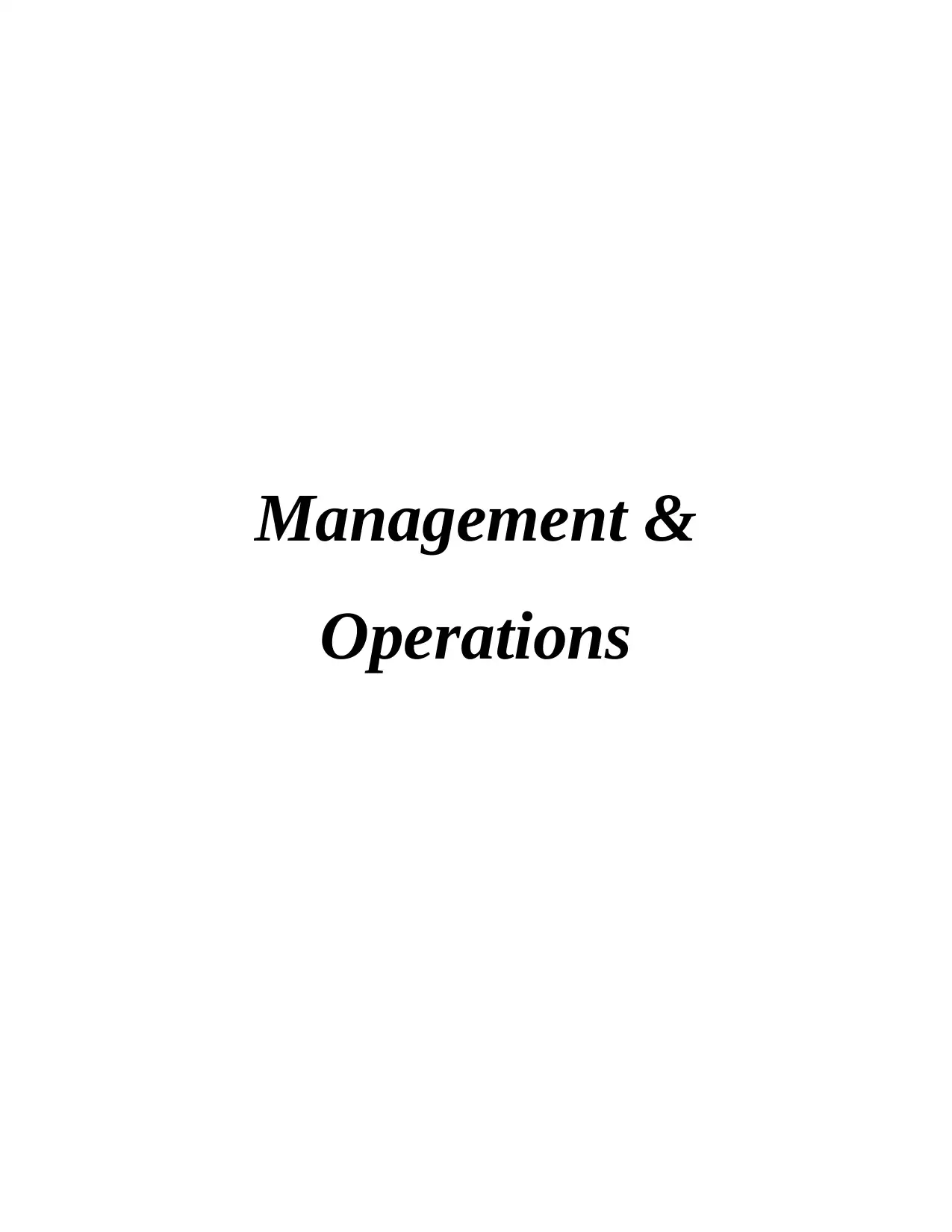
Management &
Operations
Operations
Secure Best Marks with AI Grader
Need help grading? Try our AI Grader for instant feedback on your assignments.
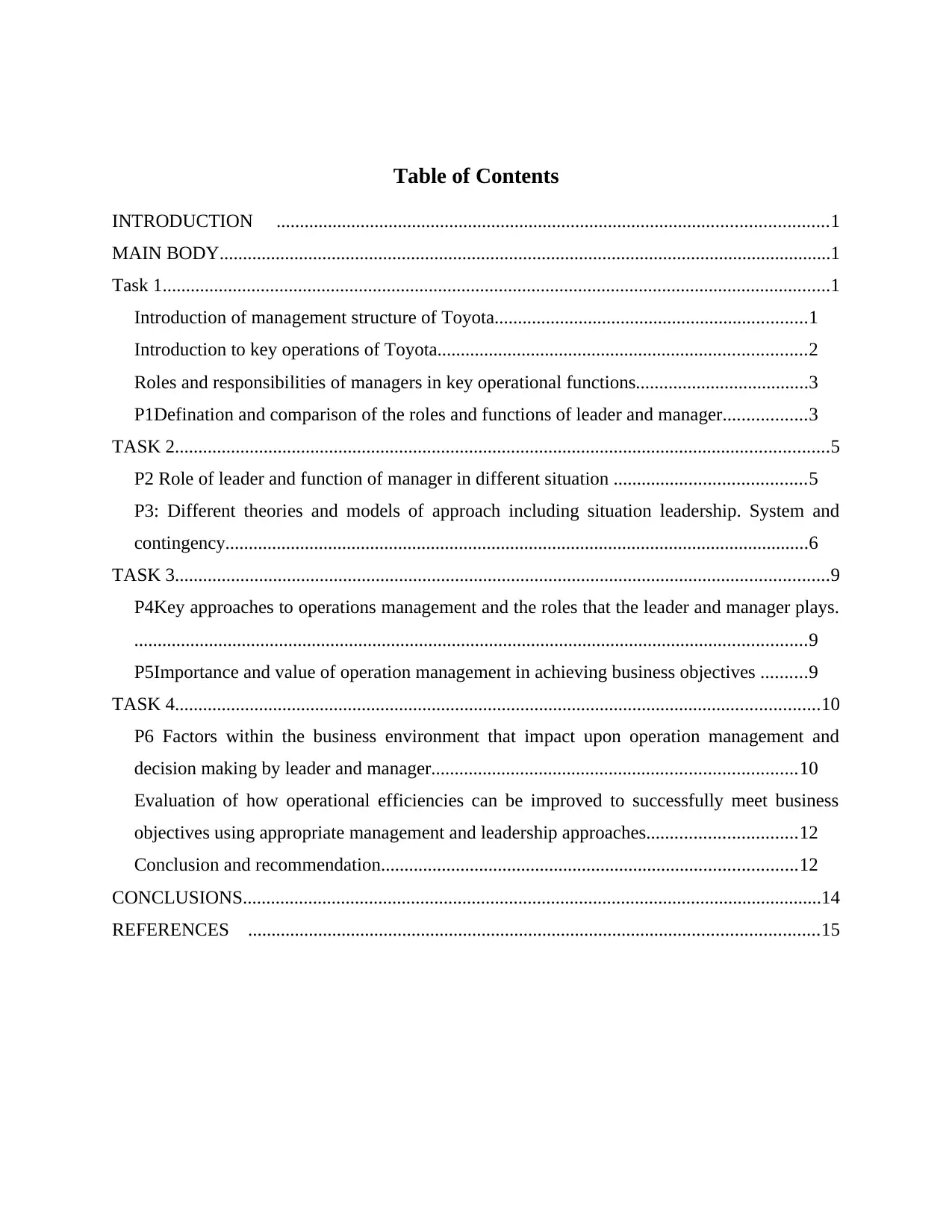
Table of Contents
INTRODUCTION ......................................................................................................................1
MAIN BODY...................................................................................................................................1
Task 1...............................................................................................................................................1
Introduction of management structure of Toyota...................................................................1
Introduction to key operations of Toyota...............................................................................2
Roles and responsibilities of managers in key operational functions.....................................3
P1Defination and comparison of the roles and functions of leader and manager..................3
TASK 2............................................................................................................................................5
P2 Role of leader and function of manager in different situation .........................................5
P3: Different theories and models of approach including situation leadership. System and
contingency.............................................................................................................................6
TASK 3............................................................................................................................................9
P4Key approaches to operations management and the roles that the leader and manager plays.
................................................................................................................................................9
P5Importance and value of operation management in achieving business objectives ..........9
TASK 4..........................................................................................................................................10
P6 Factors within the business environment that impact upon operation management and
decision making by leader and manager..............................................................................10
Evaluation of how operational efficiencies can be improved to successfully meet business
objectives using appropriate management and leadership approaches................................12
Conclusion and recommendation.........................................................................................12
CONCLUSIONS............................................................................................................................14
REFERENCES ..........................................................................................................................15
INTRODUCTION ......................................................................................................................1
MAIN BODY...................................................................................................................................1
Task 1...............................................................................................................................................1
Introduction of management structure of Toyota...................................................................1
Introduction to key operations of Toyota...............................................................................2
Roles and responsibilities of managers in key operational functions.....................................3
P1Defination and comparison of the roles and functions of leader and manager..................3
TASK 2............................................................................................................................................5
P2 Role of leader and function of manager in different situation .........................................5
P3: Different theories and models of approach including situation leadership. System and
contingency.............................................................................................................................6
TASK 3............................................................................................................................................9
P4Key approaches to operations management and the roles that the leader and manager plays.
................................................................................................................................................9
P5Importance and value of operation management in achieving business objectives ..........9
TASK 4..........................................................................................................................................10
P6 Factors within the business environment that impact upon operation management and
decision making by leader and manager..............................................................................10
Evaluation of how operational efficiencies can be improved to successfully meet business
objectives using appropriate management and leadership approaches................................12
Conclusion and recommendation.........................................................................................12
CONCLUSIONS............................................................................................................................14
REFERENCES ..........................................................................................................................15

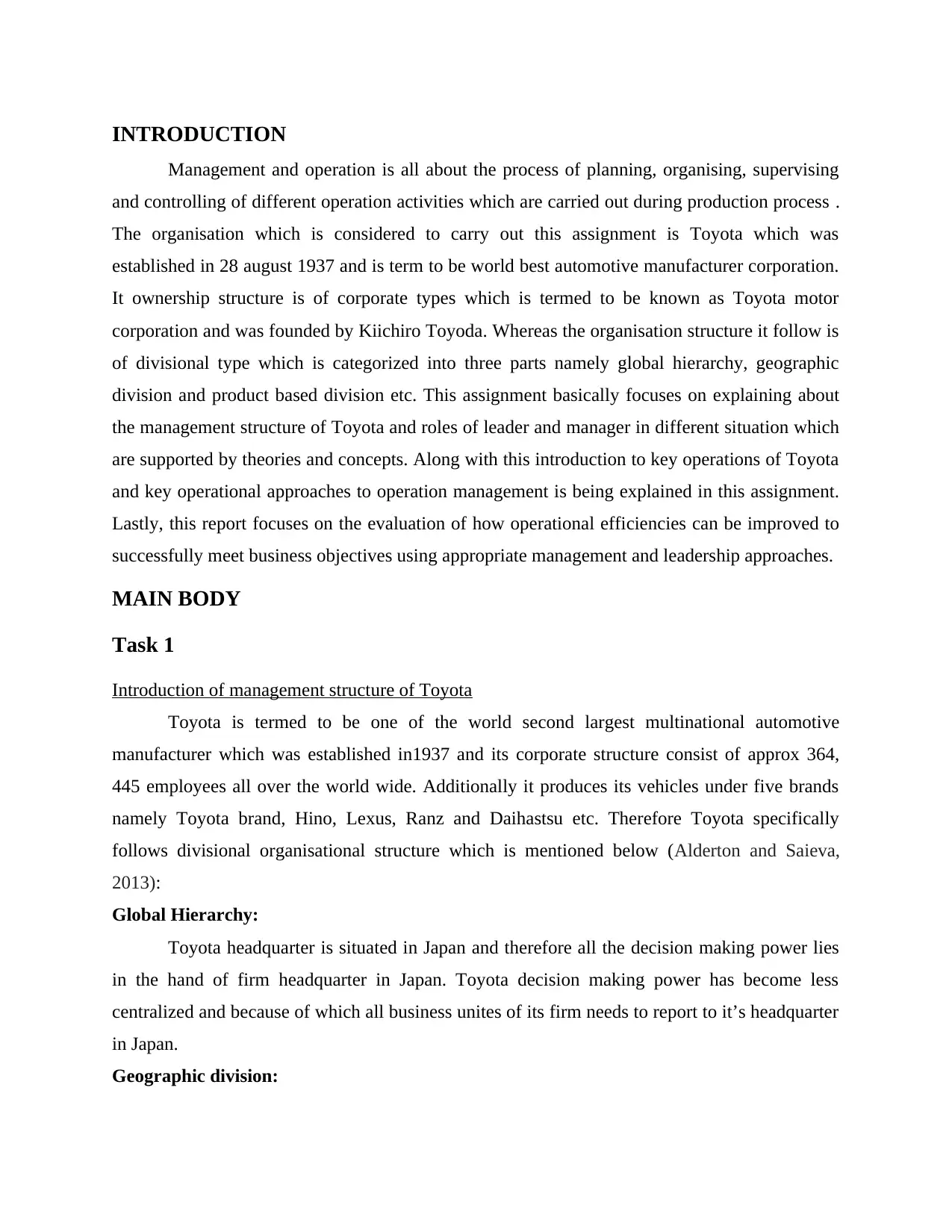
INTRODUCTION
Management and operation is all about the process of planning, organising, supervising
and controlling of different operation activities which are carried out during production process .
The organisation which is considered to carry out this assignment is Toyota which was
established in 28 august 1937 and is term to be world best automotive manufacturer corporation.
It ownership structure is of corporate types which is termed to be known as Toyota motor
corporation and was founded by Kiichiro Toyoda. Whereas the organisation structure it follow is
of divisional type which is categorized into three parts namely global hierarchy, geographic
division and product based division etc. This assignment basically focuses on explaining about
the management structure of Toyota and roles of leader and manager in different situation which
are supported by theories and concepts. Along with this introduction to key operations of Toyota
and key operational approaches to operation management is being explained in this assignment.
Lastly, this report focuses on the evaluation of how operational efficiencies can be improved to
successfully meet business objectives using appropriate management and leadership approaches.
MAIN BODY
Task 1
Introduction of management structure of Toyota
Toyota is termed to be one of the world second largest multinational automotive
manufacturer which was established in1937 and its corporate structure consist of approx 364,
445 employees all over the world wide. Additionally it produces its vehicles under five brands
namely Toyota brand, Hino, Lexus, Ranz and Daihastsu etc. Therefore Toyota specifically
follows divisional organisational structure which is mentioned below (Alderton and Saieva,
2013):
Global Hierarchy:
Toyota headquarter is situated in Japan and therefore all the decision making power lies
in the hand of firm headquarter in Japan. Toyota decision making power has become less
centralized and because of which all business unites of its firm needs to report to it’s headquarter
in Japan.
Geographic division:
Management and operation is all about the process of planning, organising, supervising
and controlling of different operation activities which are carried out during production process .
The organisation which is considered to carry out this assignment is Toyota which was
established in 28 august 1937 and is term to be world best automotive manufacturer corporation.
It ownership structure is of corporate types which is termed to be known as Toyota motor
corporation and was founded by Kiichiro Toyoda. Whereas the organisation structure it follow is
of divisional type which is categorized into three parts namely global hierarchy, geographic
division and product based division etc. This assignment basically focuses on explaining about
the management structure of Toyota and roles of leader and manager in different situation which
are supported by theories and concepts. Along with this introduction to key operations of Toyota
and key operational approaches to operation management is being explained in this assignment.
Lastly, this report focuses on the evaluation of how operational efficiencies can be improved to
successfully meet business objectives using appropriate management and leadership approaches.
MAIN BODY
Task 1
Introduction of management structure of Toyota
Toyota is termed to be one of the world second largest multinational automotive
manufacturer which was established in1937 and its corporate structure consist of approx 364,
445 employees all over the world wide. Additionally it produces its vehicles under five brands
namely Toyota brand, Hino, Lexus, Ranz and Daihastsu etc. Therefore Toyota specifically
follows divisional organisational structure which is mentioned below (Alderton and Saieva,
2013):
Global Hierarchy:
Toyota headquarter is situated in Japan and therefore all the decision making power lies
in the hand of firm headquarter in Japan. Toyota decision making power has become less
centralized and because of which all business unites of its firm needs to report to it’s headquarter
in Japan.
Geographic division:
Secure Best Marks with AI Grader
Need help grading? Try our AI Grader for instant feedback on your assignments.
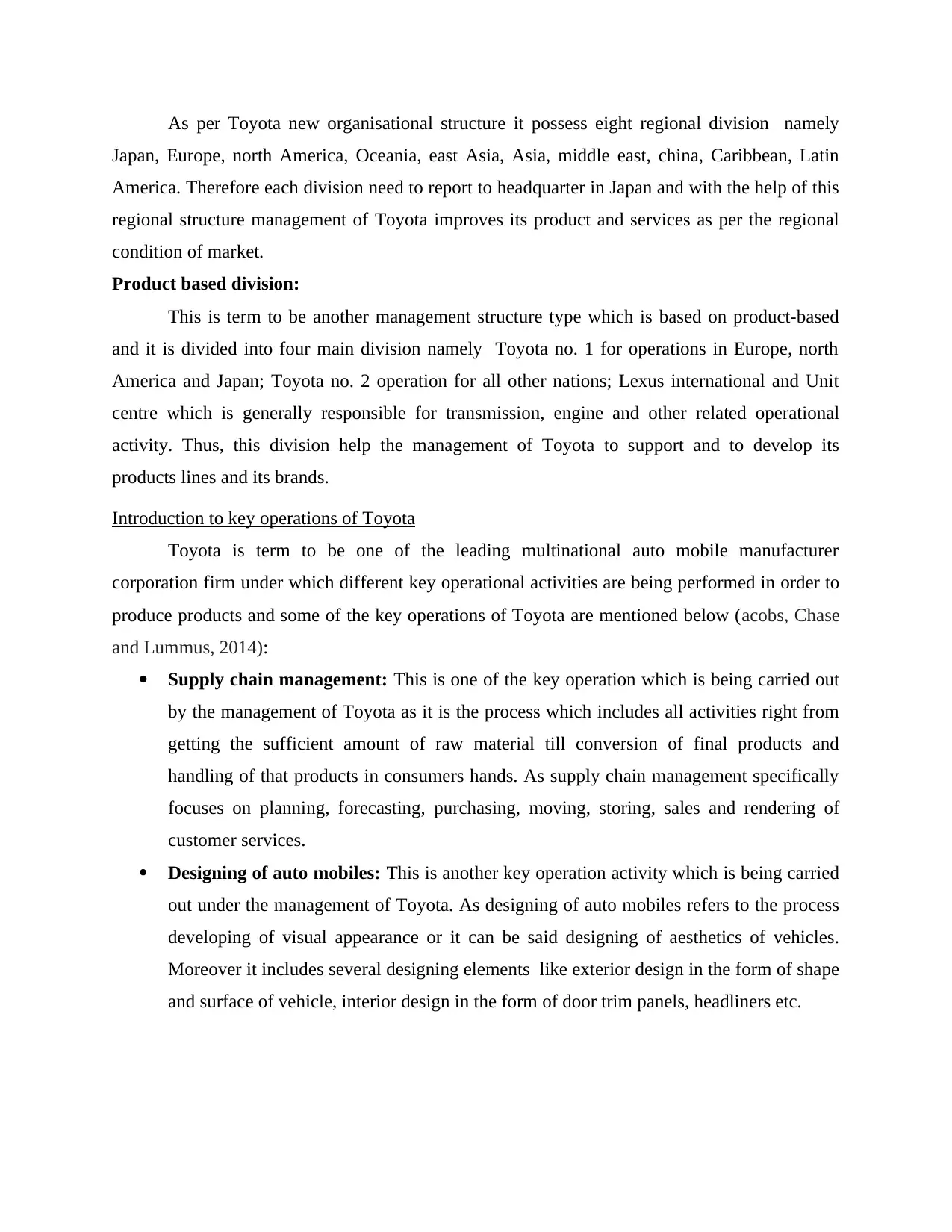
As per Toyota new organisational structure it possess eight regional division namely
Japan, Europe, north America, Oceania, east Asia, Asia, middle east, china, Caribbean, Latin
America. Therefore each division need to report to headquarter in Japan and with the help of this
regional structure management of Toyota improves its product and services as per the regional
condition of market.
Product based division:
This is term to be another management structure type which is based on product-based
and it is divided into four main division namely Toyota no. 1 for operations in Europe, north
America and Japan; Toyota no. 2 operation for all other nations; Lexus international and Unit
centre which is generally responsible for transmission, engine and other related operational
activity. Thus, this division help the management of Toyota to support and to develop its
products lines and its brands.
Introduction to key operations of Toyota
Toyota is term to be one of the leading multinational auto mobile manufacturer
corporation firm under which different key operational activities are being performed in order to
produce products and some of the key operations of Toyota are mentioned below (acobs, Chase
and Lummus, 2014):
Supply chain management: This is one of the key operation which is being carried out
by the management of Toyota as it is the process which includes all activities right from
getting the sufficient amount of raw material till conversion of final products and
handling of that products in consumers hands. As supply chain management specifically
focuses on planning, forecasting, purchasing, moving, storing, sales and rendering of
customer services.
Designing of auto mobiles: This is another key operation activity which is being carried
out under the management of Toyota. As designing of auto mobiles refers to the process
developing of visual appearance or it can be said designing of aesthetics of vehicles.
Moreover it includes several designing elements like exterior design in the form of shape
and surface of vehicle, interior design in the form of door trim panels, headliners etc.
Japan, Europe, north America, Oceania, east Asia, Asia, middle east, china, Caribbean, Latin
America. Therefore each division need to report to headquarter in Japan and with the help of this
regional structure management of Toyota improves its product and services as per the regional
condition of market.
Product based division:
This is term to be another management structure type which is based on product-based
and it is divided into four main division namely Toyota no. 1 for operations in Europe, north
America and Japan; Toyota no. 2 operation for all other nations; Lexus international and Unit
centre which is generally responsible for transmission, engine and other related operational
activity. Thus, this division help the management of Toyota to support and to develop its
products lines and its brands.
Introduction to key operations of Toyota
Toyota is term to be one of the leading multinational auto mobile manufacturer
corporation firm under which different key operational activities are being performed in order to
produce products and some of the key operations of Toyota are mentioned below (acobs, Chase
and Lummus, 2014):
Supply chain management: This is one of the key operation which is being carried out
by the management of Toyota as it is the process which includes all activities right from
getting the sufficient amount of raw material till conversion of final products and
handling of that products in consumers hands. As supply chain management specifically
focuses on planning, forecasting, purchasing, moving, storing, sales and rendering of
customer services.
Designing of auto mobiles: This is another key operation activity which is being carried
out under the management of Toyota. As designing of auto mobiles refers to the process
developing of visual appearance or it can be said designing of aesthetics of vehicles.
Moreover it includes several designing elements like exterior design in the form of shape
and surface of vehicle, interior design in the form of door trim panels, headliners etc.
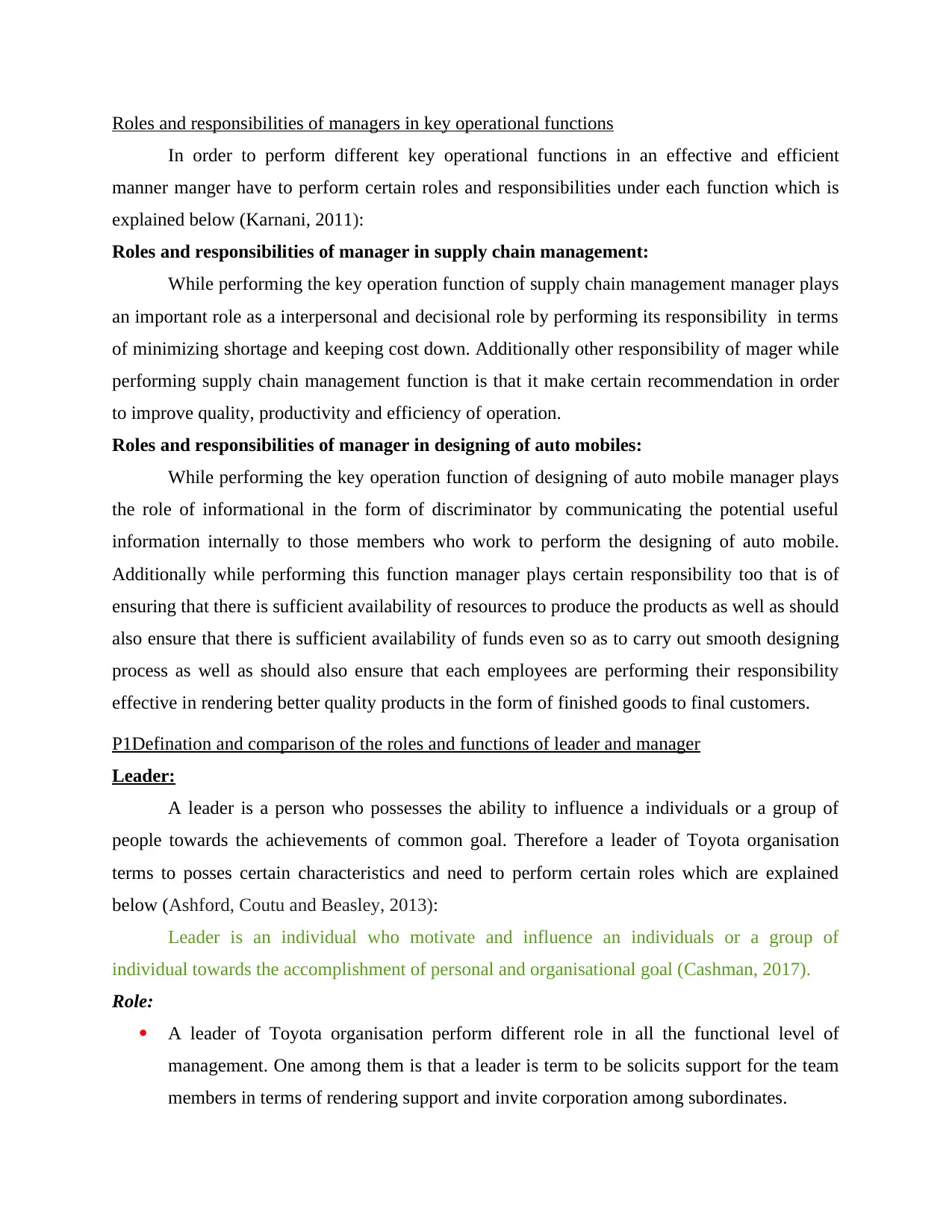
Roles and responsibilities of managers in key operational functions
In order to perform different key operational functions in an effective and efficient
manner manger have to perform certain roles and responsibilities under each function which is
explained below (Karnani, 2011):
Roles and responsibilities of manager in supply chain management:
While performing the key operation function of supply chain management manager plays
an important role as a interpersonal and decisional role by performing its responsibility in terms
of minimizing shortage and keeping cost down. Additionally other responsibility of mager while
performing supply chain management function is that it make certain recommendation in order
to improve quality, productivity and efficiency of operation.
Roles and responsibilities of manager in designing of auto mobiles:
While performing the key operation function of designing of auto mobile manager plays
the role of informational in the form of discriminator by communicating the potential useful
information internally to those members who work to perform the designing of auto mobile.
Additionally while performing this function manager plays certain responsibility too that is of
ensuring that there is sufficient availability of resources to produce the products as well as should
also ensure that there is sufficient availability of funds even so as to carry out smooth designing
process as well as should also ensure that each employees are performing their responsibility
effective in rendering better quality products in the form of finished goods to final customers.
P1Defination and comparison of the roles and functions of leader and manager
Leader:
A leader is a person who possesses the ability to influence a individuals or a group of
people towards the achievements of common goal. Therefore a leader of Toyota organisation
terms to posses certain characteristics and need to perform certain roles which are explained
below (Ashford, Coutu and Beasley, 2013):
Leader is an individual who motivate and influence an individuals or a group of
individual towards the accomplishment of personal and organisational goal (Cashman, 2017).
Role:
A leader of Toyota organisation perform different role in all the functional level of
management. One among them is that a leader is term to be solicits support for the team
members in terms of rendering support and invite corporation among subordinates.
In order to perform different key operational functions in an effective and efficient
manner manger have to perform certain roles and responsibilities under each function which is
explained below (Karnani, 2011):
Roles and responsibilities of manager in supply chain management:
While performing the key operation function of supply chain management manager plays
an important role as a interpersonal and decisional role by performing its responsibility in terms
of minimizing shortage and keeping cost down. Additionally other responsibility of mager while
performing supply chain management function is that it make certain recommendation in order
to improve quality, productivity and efficiency of operation.
Roles and responsibilities of manager in designing of auto mobiles:
While performing the key operation function of designing of auto mobile manager plays
the role of informational in the form of discriminator by communicating the potential useful
information internally to those members who work to perform the designing of auto mobile.
Additionally while performing this function manager plays certain responsibility too that is of
ensuring that there is sufficient availability of resources to produce the products as well as should
also ensure that there is sufficient availability of funds even so as to carry out smooth designing
process as well as should also ensure that each employees are performing their responsibility
effective in rendering better quality products in the form of finished goods to final customers.
P1Defination and comparison of the roles and functions of leader and manager
Leader:
A leader is a person who possesses the ability to influence a individuals or a group of
people towards the achievements of common goal. Therefore a leader of Toyota organisation
terms to posses certain characteristics and need to perform certain roles which are explained
below (Ashford, Coutu and Beasley, 2013):
Leader is an individual who motivate and influence an individuals or a group of
individual towards the accomplishment of personal and organisational goal (Cashman, 2017).
Role:
A leader of Toyota organisation perform different role in all the functional level of
management. One among them is that a leader is term to be solicits support for the team
members in terms of rendering support and invite corporation among subordinates.
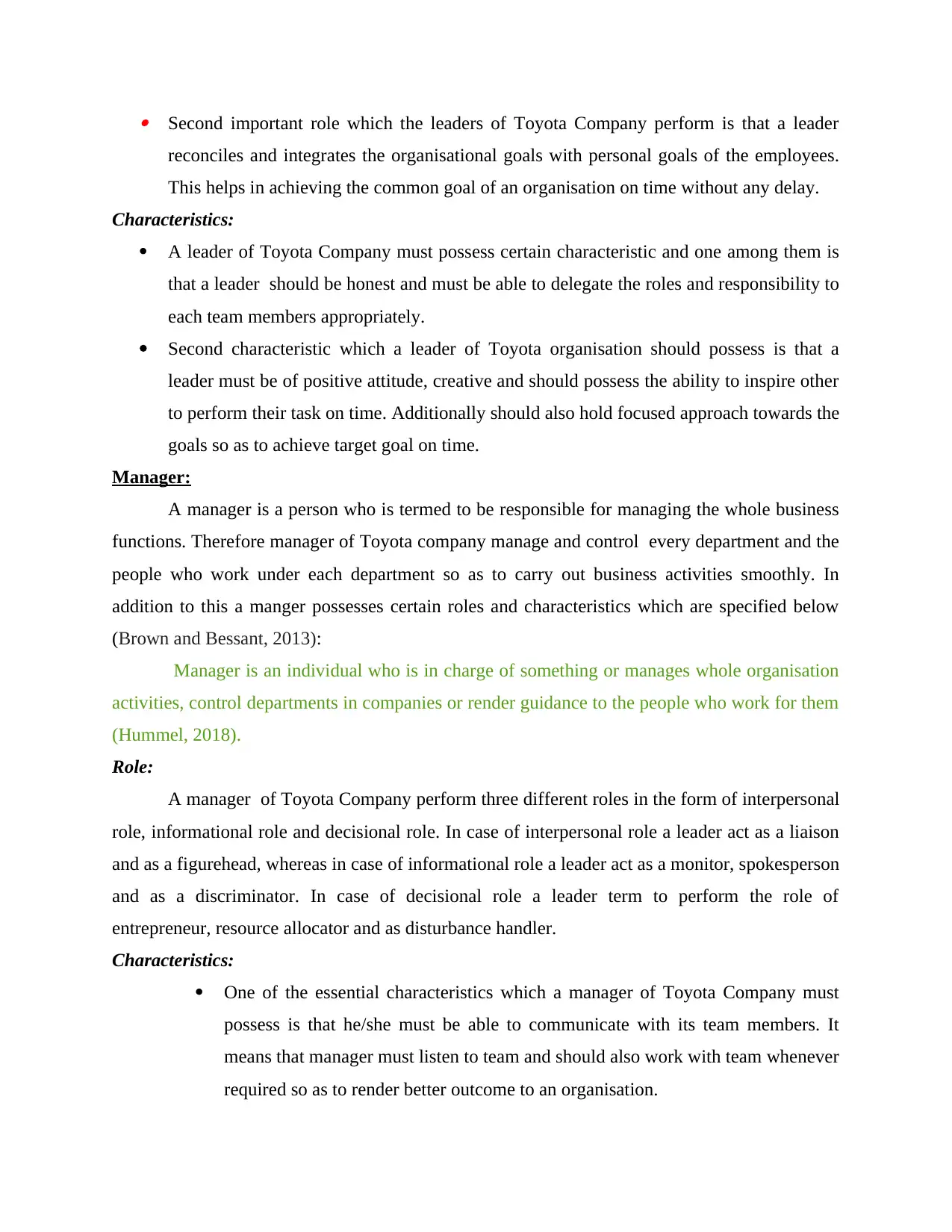
Second important role which the leaders of Toyota Company perform is that a leader
reconciles and integrates the organisational goals with personal goals of the employees.
This helps in achieving the common goal of an organisation on time without any delay.
Characteristics:
A leader of Toyota Company must possess certain characteristic and one among them is
that a leader should be honest and must be able to delegate the roles and responsibility to
each team members appropriately.
Second characteristic which a leader of Toyota organisation should possess is that a
leader must be of positive attitude, creative and should possess the ability to inspire other
to perform their task on time. Additionally should also hold focused approach towards the
goals so as to achieve target goal on time.
Manager:
A manager is a person who is termed to be responsible for managing the whole business
functions. Therefore manager of Toyota company manage and control every department and the
people who work under each department so as to carry out business activities smoothly. In
addition to this a manger possesses certain roles and characteristics which are specified below
(Brown and Bessant, 2013):
Manager is an individual who is in charge of something or manages whole organisation
activities, control departments in companies or render guidance to the people who work for them
(Hummel, 2018).
Role:
A manager of Toyota Company perform three different roles in the form of interpersonal
role, informational role and decisional role. In case of interpersonal role a leader act as a liaison
and as a figurehead, whereas in case of informational role a leader act as a monitor, spokesperson
and as a discriminator. In case of decisional role a leader term to perform the role of
entrepreneur, resource allocator and as disturbance handler.
Characteristics:
One of the essential characteristics which a manager of Toyota Company must
possess is that he/she must be able to communicate with its team members. It
means that manager must listen to team and should also work with team whenever
required so as to render better outcome to an organisation.
reconciles and integrates the organisational goals with personal goals of the employees.
This helps in achieving the common goal of an organisation on time without any delay.
Characteristics:
A leader of Toyota Company must possess certain characteristic and one among them is
that a leader should be honest and must be able to delegate the roles and responsibility to
each team members appropriately.
Second characteristic which a leader of Toyota organisation should possess is that a
leader must be of positive attitude, creative and should possess the ability to inspire other
to perform their task on time. Additionally should also hold focused approach towards the
goals so as to achieve target goal on time.
Manager:
A manager is a person who is termed to be responsible for managing the whole business
functions. Therefore manager of Toyota company manage and control every department and the
people who work under each department so as to carry out business activities smoothly. In
addition to this a manger possesses certain roles and characteristics which are specified below
(Brown and Bessant, 2013):
Manager is an individual who is in charge of something or manages whole organisation
activities, control departments in companies or render guidance to the people who work for them
(Hummel, 2018).
Role:
A manager of Toyota Company perform three different roles in the form of interpersonal
role, informational role and decisional role. In case of interpersonal role a leader act as a liaison
and as a figurehead, whereas in case of informational role a leader act as a monitor, spokesperson
and as a discriminator. In case of decisional role a leader term to perform the role of
entrepreneur, resource allocator and as disturbance handler.
Characteristics:
One of the essential characteristics which a manager of Toyota Company must
possess is that he/she must be able to communicate with its team members. It
means that manager must listen to team and should also work with team whenever
required so as to render better outcome to an organisation.
Paraphrase This Document
Need a fresh take? Get an instant paraphrase of this document with our AI Paraphraser
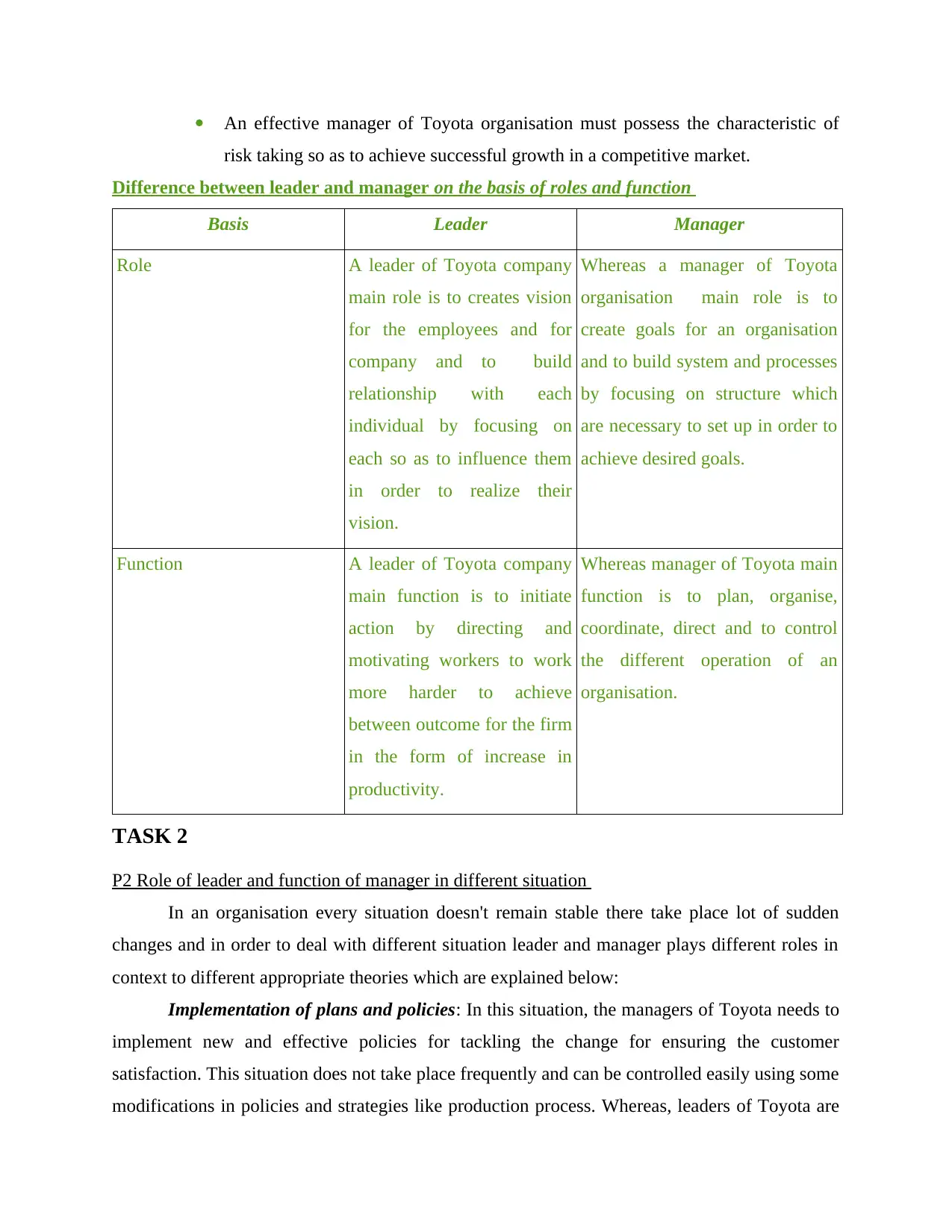
An effective manager of Toyota organisation must possess the characteristic of
risk taking so as to achieve successful growth in a competitive market.
Difference between leader and manager on the basis of roles and function
Basis Leader Manager
Role A leader of Toyota company
main role is to creates vision
for the employees and for
company and to build
relationship with each
individual by focusing on
each so as to influence them
in order to realize their
vision.
Whereas a manager of Toyota
organisation main role is to
create goals for an organisation
and to build system and processes
by focusing on structure which
are necessary to set up in order to
achieve desired goals.
Function A leader of Toyota company
main function is to initiate
action by directing and
motivating workers to work
more harder to achieve
between outcome for the firm
in the form of increase in
productivity.
Whereas manager of Toyota main
function is to plan, organise,
coordinate, direct and to control
the different operation of an
organisation.
TASK 2
P2 Role of leader and function of manager in different situation
In an organisation every situation doesn't remain stable there take place lot of sudden
changes and in order to deal with different situation leader and manager plays different roles in
context to different appropriate theories which are explained below:
Implementation of plans and policies: In this situation, the managers of Toyota needs to
implement new and effective policies for tackling the change for ensuring the customer
satisfaction. This situation does not take place frequently and can be controlled easily using some
modifications in policies and strategies like production process. Whereas, leaders of Toyota are
risk taking so as to achieve successful growth in a competitive market.
Difference between leader and manager on the basis of roles and function
Basis Leader Manager
Role A leader of Toyota company
main role is to creates vision
for the employees and for
company and to build
relationship with each
individual by focusing on
each so as to influence them
in order to realize their
vision.
Whereas a manager of Toyota
organisation main role is to
create goals for an organisation
and to build system and processes
by focusing on structure which
are necessary to set up in order to
achieve desired goals.
Function A leader of Toyota company
main function is to initiate
action by directing and
motivating workers to work
more harder to achieve
between outcome for the firm
in the form of increase in
productivity.
Whereas manager of Toyota main
function is to plan, organise,
coordinate, direct and to control
the different operation of an
organisation.
TASK 2
P2 Role of leader and function of manager in different situation
In an organisation every situation doesn't remain stable there take place lot of sudden
changes and in order to deal with different situation leader and manager plays different roles in
context to different appropriate theories which are explained below:
Implementation of plans and policies: In this situation, the managers of Toyota needs to
implement new and effective policies for tackling the change for ensuring the customer
satisfaction. This situation does not take place frequently and can be controlled easily using some
modifications in policies and strategies like production process. Whereas, leaders of Toyota are
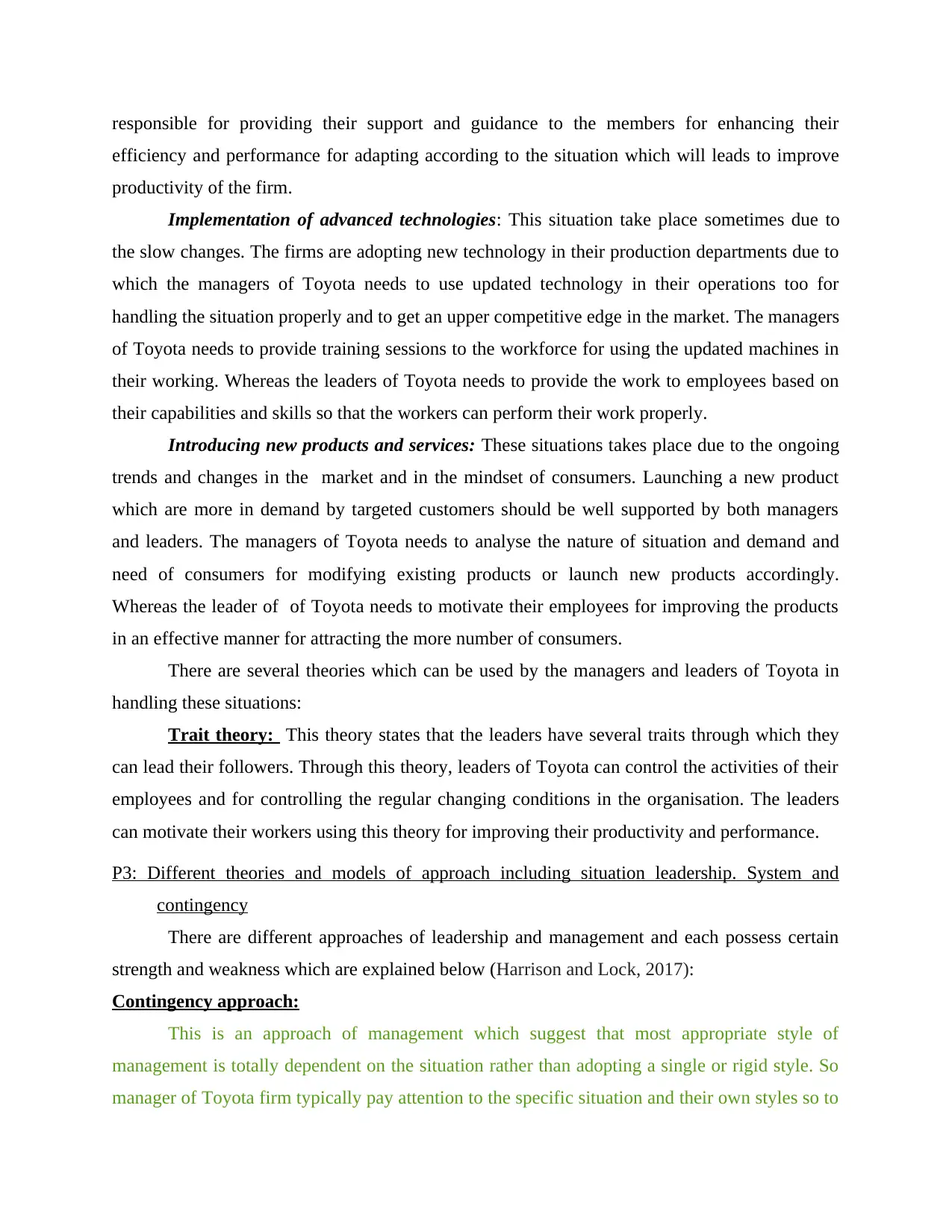
responsible for providing their support and guidance to the members for enhancing their
efficiency and performance for adapting according to the situation which will leads to improve
productivity of the firm.
Implementation of advanced technologies: This situation take place sometimes due to
the slow changes. The firms are adopting new technology in their production departments due to
which the managers of Toyota needs to use updated technology in their operations too for
handling the situation properly and to get an upper competitive edge in the market. The managers
of Toyota needs to provide training sessions to the workforce for using the updated machines in
their working. Whereas the leaders of Toyota needs to provide the work to employees based on
their capabilities and skills so that the workers can perform their work properly.
Introducing new products and services: These situations takes place due to the ongoing
trends and changes in the market and in the mindset of consumers. Launching a new product
which are more in demand by targeted customers should be well supported by both managers
and leaders. The managers of Toyota needs to analyse the nature of situation and demand and
need of consumers for modifying existing products or launch new products accordingly.
Whereas the leader of of Toyota needs to motivate their employees for improving the products
in an effective manner for attracting the more number of consumers.
There are several theories which can be used by the managers and leaders of Toyota in
handling these situations:
Trait theory: This theory states that the leaders have several traits through which they
can lead their followers. Through this theory, leaders of Toyota can control the activities of their
employees and for controlling the regular changing conditions in the organisation. The leaders
can motivate their workers using this theory for improving their productivity and performance.
P3: Different theories and models of approach including situation leadership. System and
contingency
There are different approaches of leadership and management and each possess certain
strength and weakness which are explained below (Harrison and Lock, 2017):
Contingency approach:
This is an approach of management which suggest that most appropriate style of
management is totally dependent on the situation rather than adopting a single or rigid style. So
manager of Toyota firm typically pay attention to the specific situation and their own styles so to
efficiency and performance for adapting according to the situation which will leads to improve
productivity of the firm.
Implementation of advanced technologies: This situation take place sometimes due to
the slow changes. The firms are adopting new technology in their production departments due to
which the managers of Toyota needs to use updated technology in their operations too for
handling the situation properly and to get an upper competitive edge in the market. The managers
of Toyota needs to provide training sessions to the workforce for using the updated machines in
their working. Whereas the leaders of Toyota needs to provide the work to employees based on
their capabilities and skills so that the workers can perform their work properly.
Introducing new products and services: These situations takes place due to the ongoing
trends and changes in the market and in the mindset of consumers. Launching a new product
which are more in demand by targeted customers should be well supported by both managers
and leaders. The managers of Toyota needs to analyse the nature of situation and demand and
need of consumers for modifying existing products or launch new products accordingly.
Whereas the leader of of Toyota needs to motivate their employees for improving the products
in an effective manner for attracting the more number of consumers.
There are several theories which can be used by the managers and leaders of Toyota in
handling these situations:
Trait theory: This theory states that the leaders have several traits through which they
can lead their followers. Through this theory, leaders of Toyota can control the activities of their
employees and for controlling the regular changing conditions in the organisation. The leaders
can motivate their workers using this theory for improving their productivity and performance.
P3: Different theories and models of approach including situation leadership. System and
contingency
There are different approaches of leadership and management and each possess certain
strength and weakness which are explained below (Harrison and Lock, 2017):
Contingency approach:
This is an approach of management which suggest that most appropriate style of
management is totally dependent on the situation rather than adopting a single or rigid style. So
manager of Toyota firm typically pay attention to the specific situation and their own styles so to
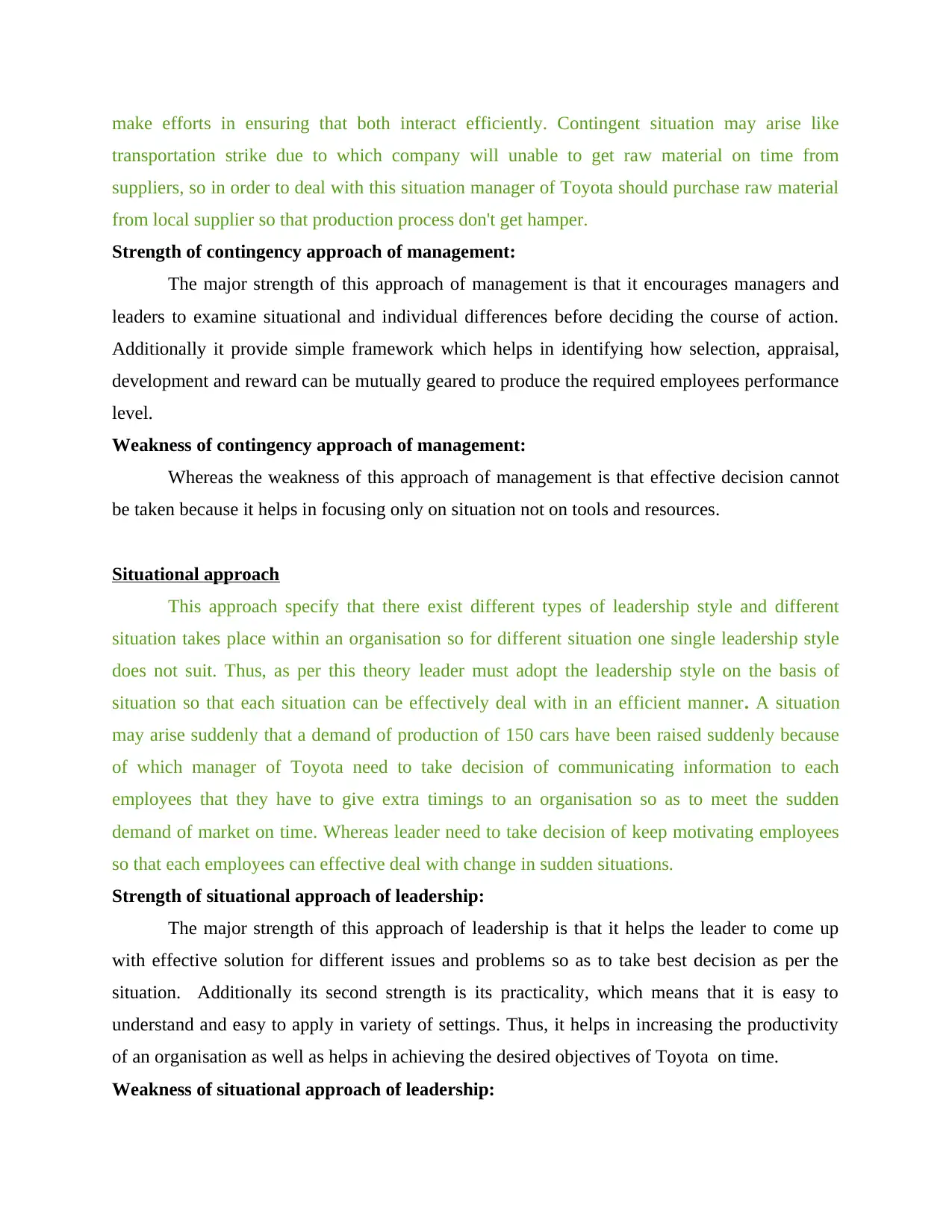
make efforts in ensuring that both interact efficiently. Contingent situation may arise like
transportation strike due to which company will unable to get raw material on time from
suppliers, so in order to deal with this situation manager of Toyota should purchase raw material
from local supplier so that production process don't get hamper.
Strength of contingency approach of management:
The major strength of this approach of management is that it encourages managers and
leaders to examine situational and individual differences before deciding the course of action.
Additionally it provide simple framework which helps in identifying how selection, appraisal,
development and reward can be mutually geared to produce the required employees performance
level.
Weakness of contingency approach of management:
Whereas the weakness of this approach of management is that effective decision cannot
be taken because it helps in focusing only on situation not on tools and resources.
Situational approach
This approach specify that there exist different types of leadership style and different
situation takes place within an organisation so for different situation one single leadership style
does not suit. Thus, as per this theory leader must adopt the leadership style on the basis of
situation so that each situation can be effectively deal with in an efficient manner. A situation
may arise suddenly that a demand of production of 150 cars have been raised suddenly because
of which manager of Toyota need to take decision of communicating information to each
employees that they have to give extra timings to an organisation so as to meet the sudden
demand of market on time. Whereas leader need to take decision of keep motivating employees
so that each employees can effective deal with change in sudden situations.
Strength of situational approach of leadership:
The major strength of this approach of leadership is that it helps the leader to come up
with effective solution for different issues and problems so as to take best decision as per the
situation. Additionally its second strength is its practicality, which means that it is easy to
understand and easy to apply in variety of settings. Thus, it helps in increasing the productivity
of an organisation as well as helps in achieving the desired objectives of Toyota on time.
Weakness of situational approach of leadership:
transportation strike due to which company will unable to get raw material on time from
suppliers, so in order to deal with this situation manager of Toyota should purchase raw material
from local supplier so that production process don't get hamper.
Strength of contingency approach of management:
The major strength of this approach of management is that it encourages managers and
leaders to examine situational and individual differences before deciding the course of action.
Additionally it provide simple framework which helps in identifying how selection, appraisal,
development and reward can be mutually geared to produce the required employees performance
level.
Weakness of contingency approach of management:
Whereas the weakness of this approach of management is that effective decision cannot
be taken because it helps in focusing only on situation not on tools and resources.
Situational approach
This approach specify that there exist different types of leadership style and different
situation takes place within an organisation so for different situation one single leadership style
does not suit. Thus, as per this theory leader must adopt the leadership style on the basis of
situation so that each situation can be effectively deal with in an efficient manner. A situation
may arise suddenly that a demand of production of 150 cars have been raised suddenly because
of which manager of Toyota need to take decision of communicating information to each
employees that they have to give extra timings to an organisation so as to meet the sudden
demand of market on time. Whereas leader need to take decision of keep motivating employees
so that each employees can effective deal with change in sudden situations.
Strength of situational approach of leadership:
The major strength of this approach of leadership is that it helps the leader to come up
with effective solution for different issues and problems so as to take best decision as per the
situation. Additionally its second strength is its practicality, which means that it is easy to
understand and easy to apply in variety of settings. Thus, it helps in increasing the productivity
of an organisation as well as helps in achieving the desired objectives of Toyota on time.
Weakness of situational approach of leadership:
Secure Best Marks with AI Grader
Need help grading? Try our AI Grader for instant feedback on your assignments.
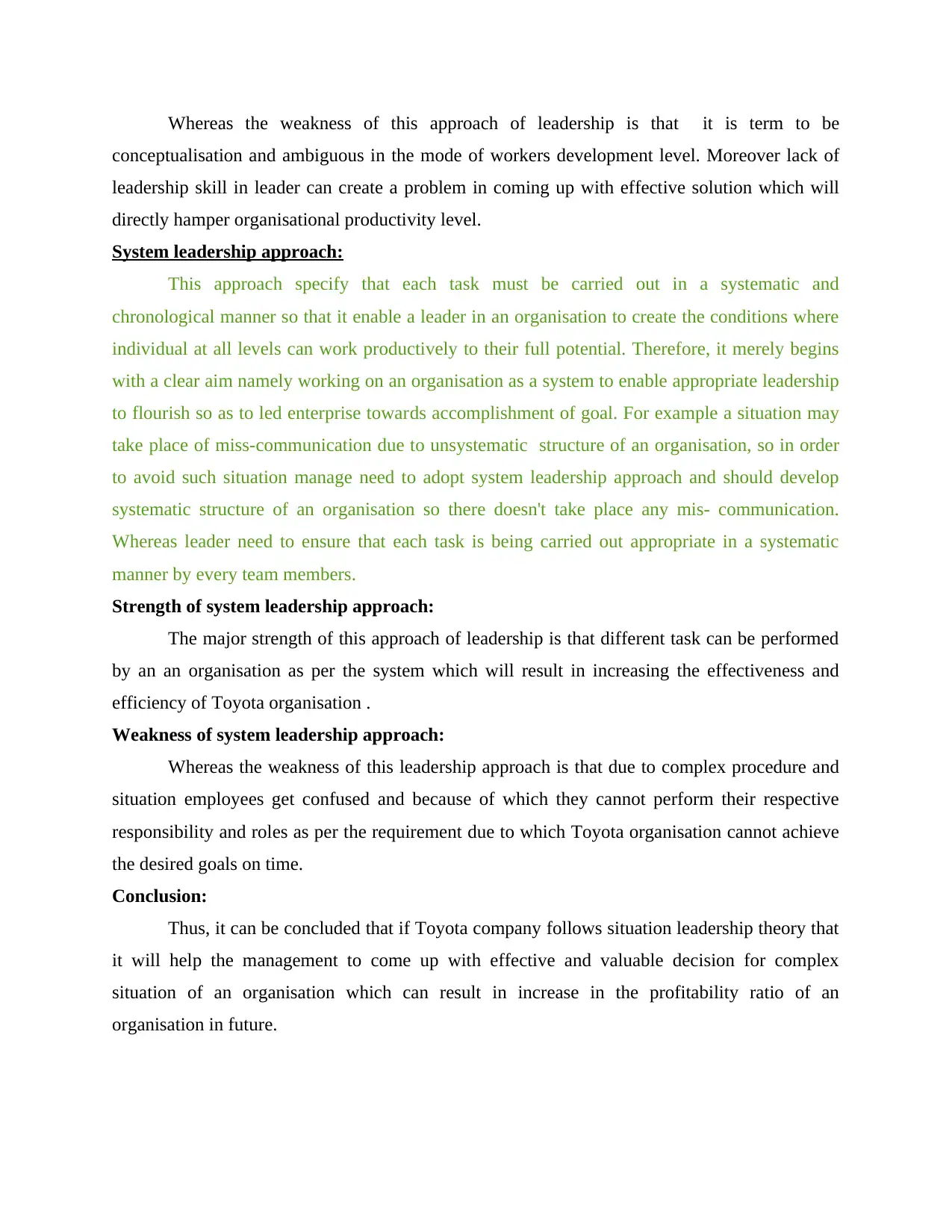
Whereas the weakness of this approach of leadership is that it is term to be
conceptualisation and ambiguous in the mode of workers development level. Moreover lack of
leadership skill in leader can create a problem in coming up with effective solution which will
directly hamper organisational productivity level.
System leadership approach:
This approach specify that each task must be carried out in a systematic and
chronological manner so that it enable a leader in an organisation to create the conditions where
individual at all levels can work productively to their full potential. Therefore, it merely begins
with a clear aim namely working on an organisation as a system to enable appropriate leadership
to flourish so as to led enterprise towards accomplishment of goal. For example a situation may
take place of miss-communication due to unsystematic structure of an organisation, so in order
to avoid such situation manage need to adopt system leadership approach and should develop
systematic structure of an organisation so there doesn't take place any mis- communication.
Whereas leader need to ensure that each task is being carried out appropriate in a systematic
manner by every team members.
Strength of system leadership approach:
The major strength of this approach of leadership is that different task can be performed
by an an organisation as per the system which will result in increasing the effectiveness and
efficiency of Toyota organisation .
Weakness of system leadership approach:
Whereas the weakness of this leadership approach is that due to complex procedure and
situation employees get confused and because of which they cannot perform their respective
responsibility and roles as per the requirement due to which Toyota organisation cannot achieve
the desired goals on time.
Conclusion:
Thus, it can be concluded that if Toyota company follows situation leadership theory that
it will help the management to come up with effective and valuable decision for complex
situation of an organisation which can result in increase in the profitability ratio of an
organisation in future.
conceptualisation and ambiguous in the mode of workers development level. Moreover lack of
leadership skill in leader can create a problem in coming up with effective solution which will
directly hamper organisational productivity level.
System leadership approach:
This approach specify that each task must be carried out in a systematic and
chronological manner so that it enable a leader in an organisation to create the conditions where
individual at all levels can work productively to their full potential. Therefore, it merely begins
with a clear aim namely working on an organisation as a system to enable appropriate leadership
to flourish so as to led enterprise towards accomplishment of goal. For example a situation may
take place of miss-communication due to unsystematic structure of an organisation, so in order
to avoid such situation manage need to adopt system leadership approach and should develop
systematic structure of an organisation so there doesn't take place any mis- communication.
Whereas leader need to ensure that each task is being carried out appropriate in a systematic
manner by every team members.
Strength of system leadership approach:
The major strength of this approach of leadership is that different task can be performed
by an an organisation as per the system which will result in increasing the effectiveness and
efficiency of Toyota organisation .
Weakness of system leadership approach:
Whereas the weakness of this leadership approach is that due to complex procedure and
situation employees get confused and because of which they cannot perform their respective
responsibility and roles as per the requirement due to which Toyota organisation cannot achieve
the desired goals on time.
Conclusion:
Thus, it can be concluded that if Toyota company follows situation leadership theory that
it will help the management to come up with effective and valuable decision for complex
situation of an organisation which can result in increase in the profitability ratio of an
organisation in future.
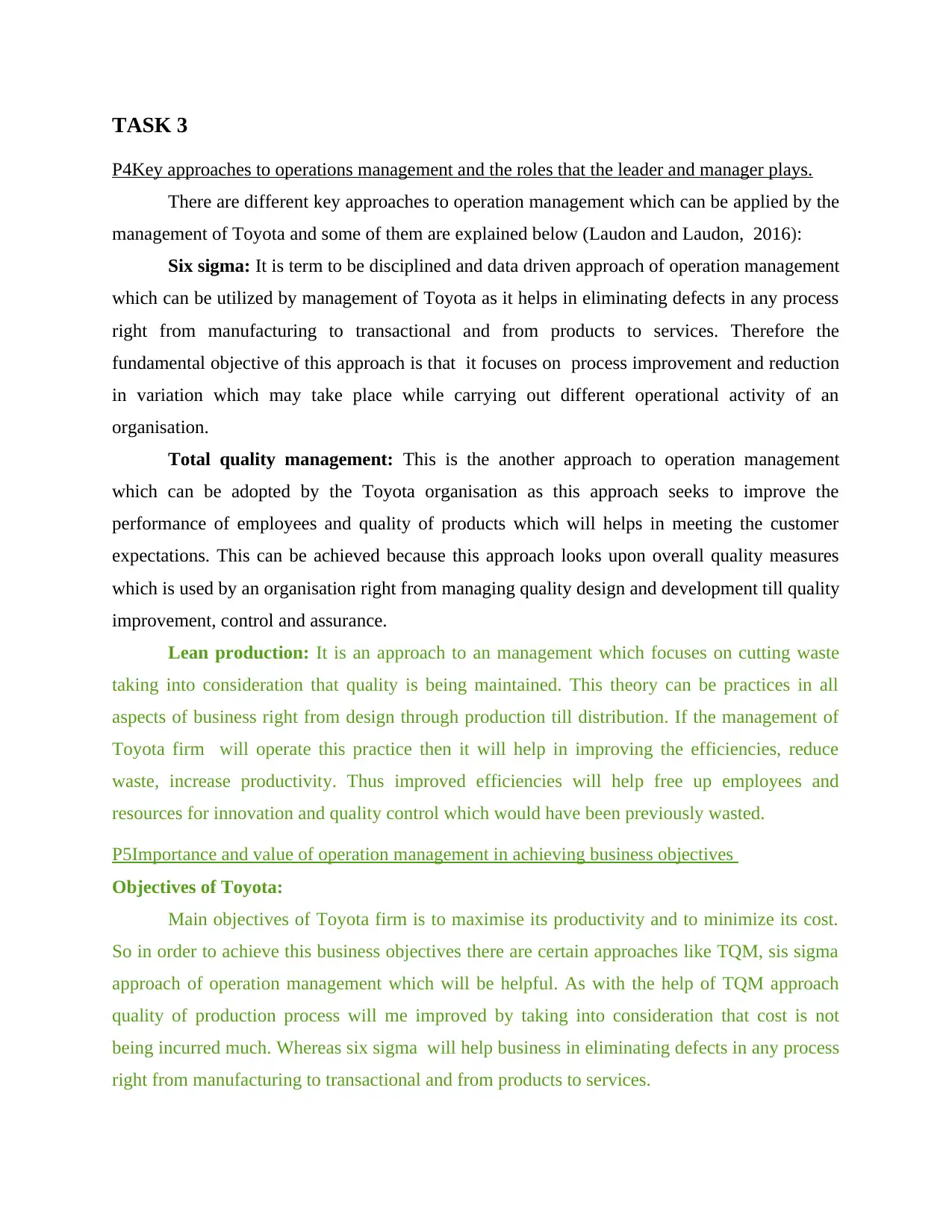
TASK 3
P4Key approaches to operations management and the roles that the leader and manager plays.
There are different key approaches to operation management which can be applied by the
management of Toyota and some of them are explained below (Laudon and Laudon, 2016):
Six sigma: It is term to be disciplined and data driven approach of operation management
which can be utilized by management of Toyota as it helps in eliminating defects in any process
right from manufacturing to transactional and from products to services. Therefore the
fundamental objective of this approach is that it focuses on process improvement and reduction
in variation which may take place while carrying out different operational activity of an
organisation.
Total quality management: This is the another approach to operation management
which can be adopted by the Toyota organisation as this approach seeks to improve the
performance of employees and quality of products which will helps in meeting the customer
expectations. This can be achieved because this approach looks upon overall quality measures
which is used by an organisation right from managing quality design and development till quality
improvement, control and assurance.
Lean production: It is an approach to an management which focuses on cutting waste
taking into consideration that quality is being maintained. This theory can be practices in all
aspects of business right from design through production till distribution. If the management of
Toyota firm will operate this practice then it will help in improving the efficiencies, reduce
waste, increase productivity. Thus improved efficiencies will help free up employees and
resources for innovation and quality control which would have been previously wasted.
P5Importance and value of operation management in achieving business objectives
Objectives of Toyota:
Main objectives of Toyota firm is to maximise its productivity and to minimize its cost.
So in order to achieve this business objectives there are certain approaches like TQM, sis sigma
approach of operation management which will be helpful. As with the help of TQM approach
quality of production process will me improved by taking into consideration that cost is not
being incurred much. Whereas six sigma will help business in eliminating defects in any process
right from manufacturing to transactional and from products to services.
P4Key approaches to operations management and the roles that the leader and manager plays.
There are different key approaches to operation management which can be applied by the
management of Toyota and some of them are explained below (Laudon and Laudon, 2016):
Six sigma: It is term to be disciplined and data driven approach of operation management
which can be utilized by management of Toyota as it helps in eliminating defects in any process
right from manufacturing to transactional and from products to services. Therefore the
fundamental objective of this approach is that it focuses on process improvement and reduction
in variation which may take place while carrying out different operational activity of an
organisation.
Total quality management: This is the another approach to operation management
which can be adopted by the Toyota organisation as this approach seeks to improve the
performance of employees and quality of products which will helps in meeting the customer
expectations. This can be achieved because this approach looks upon overall quality measures
which is used by an organisation right from managing quality design and development till quality
improvement, control and assurance.
Lean production: It is an approach to an management which focuses on cutting waste
taking into consideration that quality is being maintained. This theory can be practices in all
aspects of business right from design through production till distribution. If the management of
Toyota firm will operate this practice then it will help in improving the efficiencies, reduce
waste, increase productivity. Thus improved efficiencies will help free up employees and
resources for innovation and quality control which would have been previously wasted.
P5Importance and value of operation management in achieving business objectives
Objectives of Toyota:
Main objectives of Toyota firm is to maximise its productivity and to minimize its cost.
So in order to achieve this business objectives there are certain approaches like TQM, sis sigma
approach of operation management which will be helpful. As with the help of TQM approach
quality of production process will me improved by taking into consideration that cost is not
being incurred much. Whereas six sigma will help business in eliminating defects in any process
right from manufacturing to transactional and from products to services.
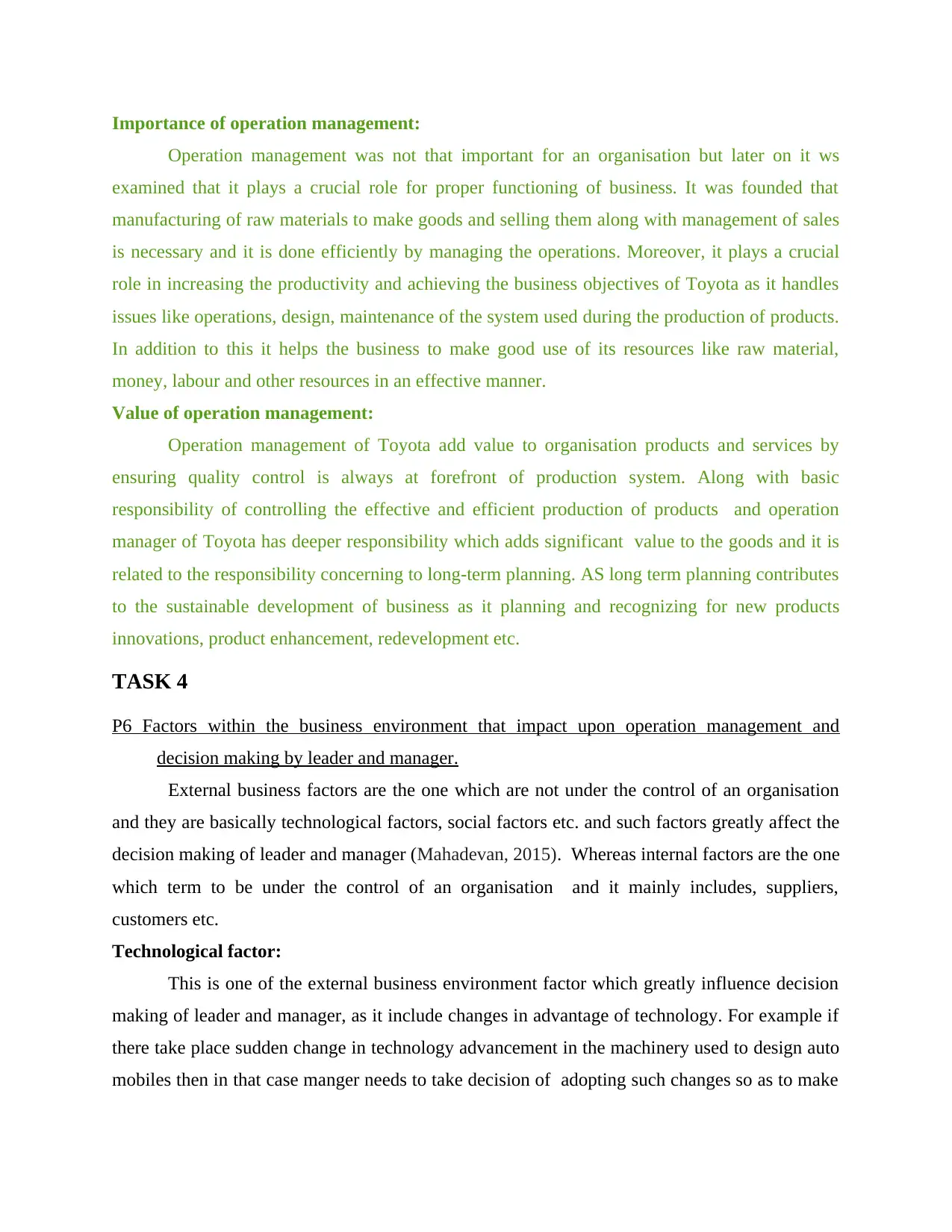
Importance of operation management:
Operation management was not that important for an organisation but later on it ws
examined that it plays a crucial role for proper functioning of business. It was founded that
manufacturing of raw materials to make goods and selling them along with management of sales
is necessary and it is done efficiently by managing the operations. Moreover, it plays a crucial
role in increasing the productivity and achieving the business objectives of Toyota as it handles
issues like operations, design, maintenance of the system used during the production of products.
In addition to this it helps the business to make good use of its resources like raw material,
money, labour and other resources in an effective manner.
Value of operation management:
Operation management of Toyota add value to organisation products and services by
ensuring quality control is always at forefront of production system. Along with basic
responsibility of controlling the effective and efficient production of products and operation
manager of Toyota has deeper responsibility which adds significant value to the goods and it is
related to the responsibility concerning to long-term planning. AS long term planning contributes
to the sustainable development of business as it planning and recognizing for new products
innovations, product enhancement, redevelopment etc.
TASK 4
P6 Factors within the business environment that impact upon operation management and
decision making by leader and manager.
External business factors are the one which are not under the control of an organisation
and they are basically technological factors, social factors etc. and such factors greatly affect the
decision making of leader and manager (Mahadevan, 2015). Whereas internal factors are the one
which term to be under the control of an organisation and it mainly includes, suppliers,
customers etc.
Technological factor:
This is one of the external business environment factor which greatly influence decision
making of leader and manager, as it include changes in advantage of technology. For example if
there take place sudden change in technology advancement in the machinery used to design auto
mobiles then in that case manger needs to take decision of adopting such changes so as to make
Operation management was not that important for an organisation but later on it ws
examined that it plays a crucial role for proper functioning of business. It was founded that
manufacturing of raw materials to make goods and selling them along with management of sales
is necessary and it is done efficiently by managing the operations. Moreover, it plays a crucial
role in increasing the productivity and achieving the business objectives of Toyota as it handles
issues like operations, design, maintenance of the system used during the production of products.
In addition to this it helps the business to make good use of its resources like raw material,
money, labour and other resources in an effective manner.
Value of operation management:
Operation management of Toyota add value to organisation products and services by
ensuring quality control is always at forefront of production system. Along with basic
responsibility of controlling the effective and efficient production of products and operation
manager of Toyota has deeper responsibility which adds significant value to the goods and it is
related to the responsibility concerning to long-term planning. AS long term planning contributes
to the sustainable development of business as it planning and recognizing for new products
innovations, product enhancement, redevelopment etc.
TASK 4
P6 Factors within the business environment that impact upon operation management and
decision making by leader and manager.
External business factors are the one which are not under the control of an organisation
and they are basically technological factors, social factors etc. and such factors greatly affect the
decision making of leader and manager (Mahadevan, 2015). Whereas internal factors are the one
which term to be under the control of an organisation and it mainly includes, suppliers,
customers etc.
Technological factor:
This is one of the external business environment factor which greatly influence decision
making of leader and manager, as it include changes in advantage of technology. For example if
there take place sudden change in technology advancement in the machinery used to design auto
mobiles then in that case manger needs to take decision of adopting such changes so as to make
Paraphrase This Document
Need a fresh take? Get an instant paraphrase of this document with our AI Paraphraser
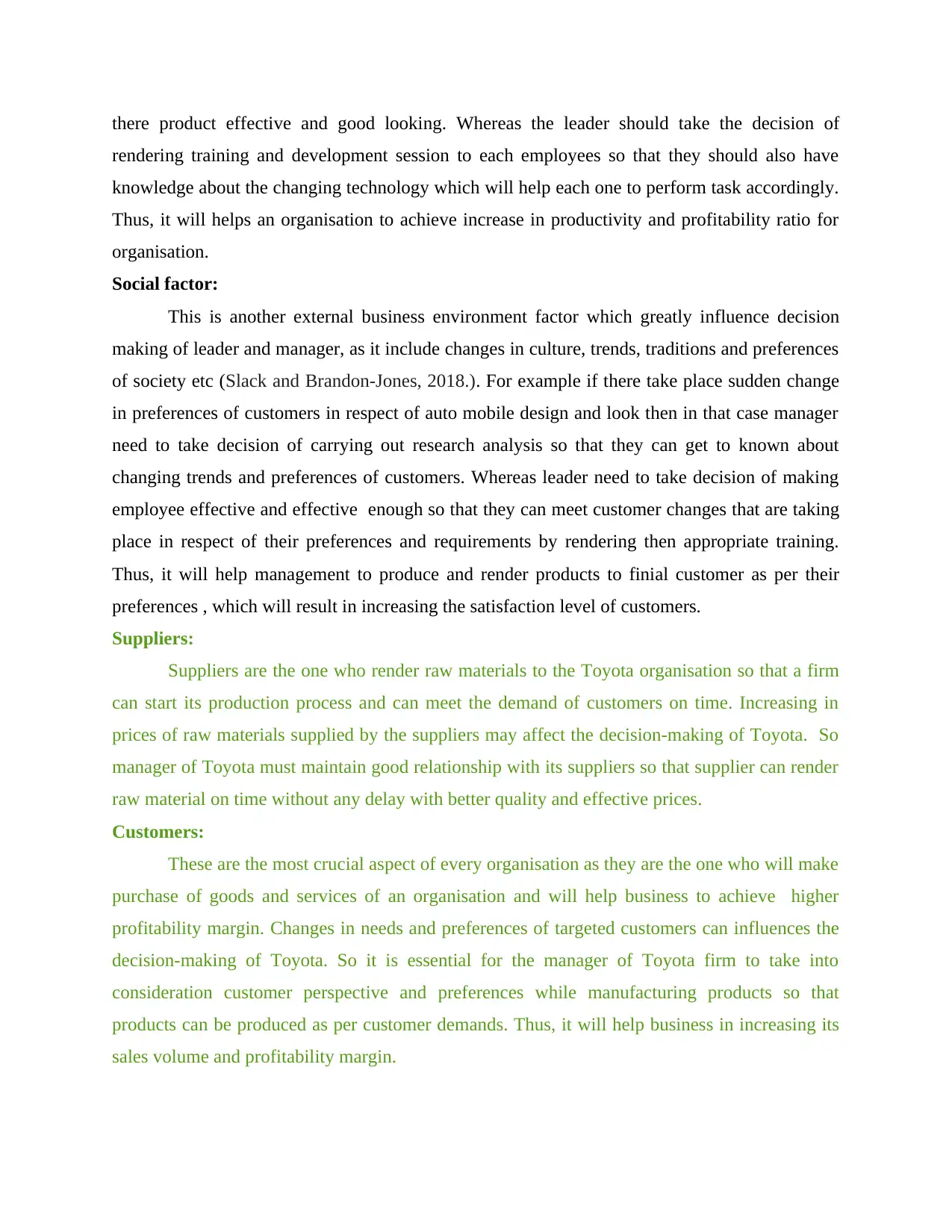
there product effective and good looking. Whereas the leader should take the decision of
rendering training and development session to each employees so that they should also have
knowledge about the changing technology which will help each one to perform task accordingly.
Thus, it will helps an organisation to achieve increase in productivity and profitability ratio for
organisation.
Social factor:
This is another external business environment factor which greatly influence decision
making of leader and manager, as it include changes in culture, trends, traditions and preferences
of society etc (Slack and Brandon-Jones, 2018.). For example if there take place sudden change
in preferences of customers in respect of auto mobile design and look then in that case manager
need to take decision of carrying out research analysis so that they can get to known about
changing trends and preferences of customers. Whereas leader need to take decision of making
employee effective and effective enough so that they can meet customer changes that are taking
place in respect of their preferences and requirements by rendering then appropriate training.
Thus, it will help management to produce and render products to finial customer as per their
preferences , which will result in increasing the satisfaction level of customers.
Suppliers:
Suppliers are the one who render raw materials to the Toyota organisation so that a firm
can start its production process and can meet the demand of customers on time. Increasing in
prices of raw materials supplied by the suppliers may affect the decision-making of Toyota. So
manager of Toyota must maintain good relationship with its suppliers so that supplier can render
raw material on time without any delay with better quality and effective prices.
Customers:
These are the most crucial aspect of every organisation as they are the one who will make
purchase of goods and services of an organisation and will help business to achieve higher
profitability margin. Changes in needs and preferences of targeted customers can influences the
decision-making of Toyota. So it is essential for the manager of Toyota firm to take into
consideration customer perspective and preferences while manufacturing products so that
products can be produced as per customer demands. Thus, it will help business in increasing its
sales volume and profitability margin.
rendering training and development session to each employees so that they should also have
knowledge about the changing technology which will help each one to perform task accordingly.
Thus, it will helps an organisation to achieve increase in productivity and profitability ratio for
organisation.
Social factor:
This is another external business environment factor which greatly influence decision
making of leader and manager, as it include changes in culture, trends, traditions and preferences
of society etc (Slack and Brandon-Jones, 2018.). For example if there take place sudden change
in preferences of customers in respect of auto mobile design and look then in that case manager
need to take decision of carrying out research analysis so that they can get to known about
changing trends and preferences of customers. Whereas leader need to take decision of making
employee effective and effective enough so that they can meet customer changes that are taking
place in respect of their preferences and requirements by rendering then appropriate training.
Thus, it will help management to produce and render products to finial customer as per their
preferences , which will result in increasing the satisfaction level of customers.
Suppliers:
Suppliers are the one who render raw materials to the Toyota organisation so that a firm
can start its production process and can meet the demand of customers on time. Increasing in
prices of raw materials supplied by the suppliers may affect the decision-making of Toyota. So
manager of Toyota must maintain good relationship with its suppliers so that supplier can render
raw material on time without any delay with better quality and effective prices.
Customers:
These are the most crucial aspect of every organisation as they are the one who will make
purchase of goods and services of an organisation and will help business to achieve higher
profitability margin. Changes in needs and preferences of targeted customers can influences the
decision-making of Toyota. So it is essential for the manager of Toyota firm to take into
consideration customer perspective and preferences while manufacturing products so that
products can be produced as per customer demands. Thus, it will help business in increasing its
sales volume and profitability margin.
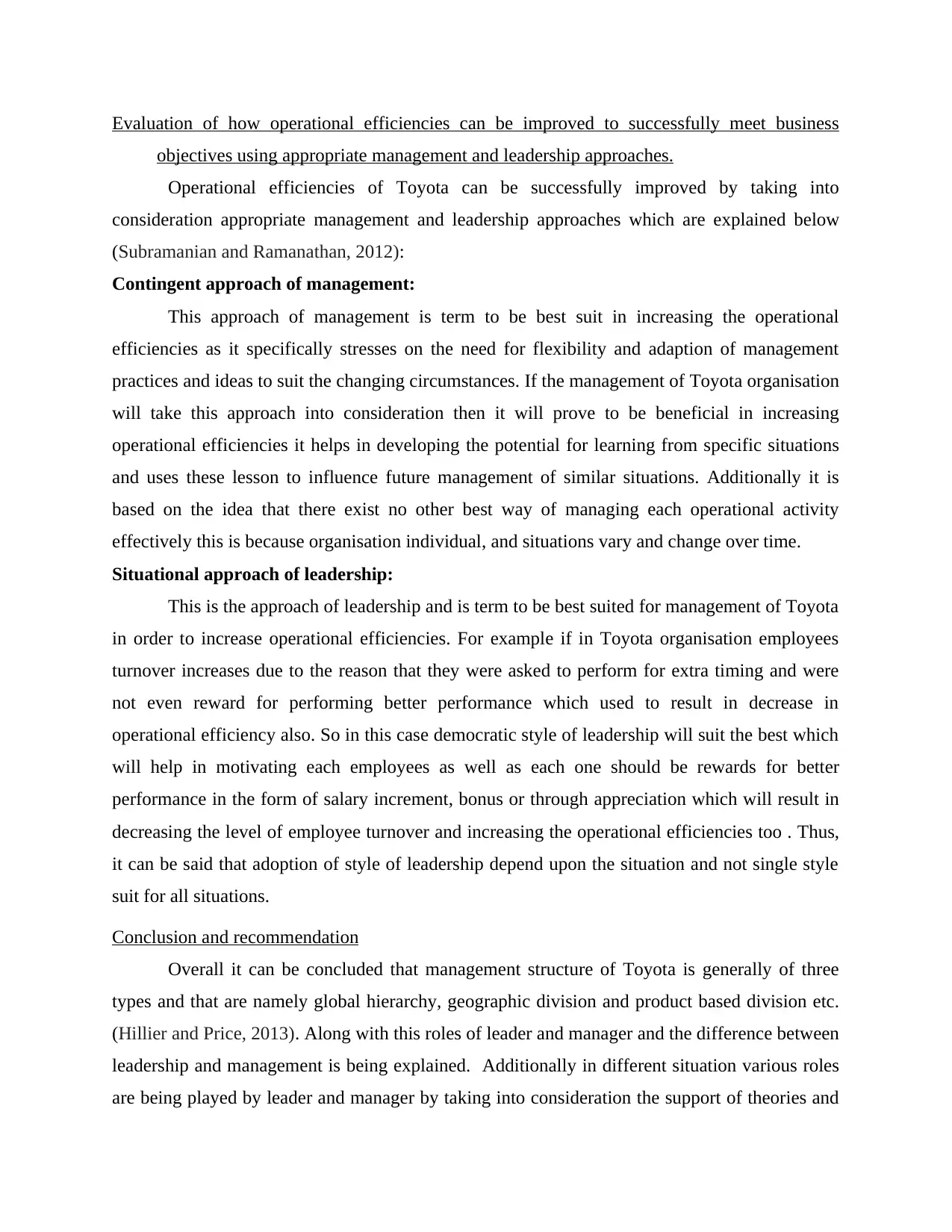
Evaluation of how operational efficiencies can be improved to successfully meet business
objectives using appropriate management and leadership approaches.
Operational efficiencies of Toyota can be successfully improved by taking into
consideration appropriate management and leadership approaches which are explained below
(Subramanian and Ramanathan, 2012):
Contingent approach of management:
This approach of management is term to be best suit in increasing the operational
efficiencies as it specifically stresses on the need for flexibility and adaption of management
practices and ideas to suit the changing circumstances. If the management of Toyota organisation
will take this approach into consideration then it will prove to be beneficial in increasing
operational efficiencies it helps in developing the potential for learning from specific situations
and uses these lesson to influence future management of similar situations. Additionally it is
based on the idea that there exist no other best way of managing each operational activity
effectively this is because organisation individual, and situations vary and change over time.
Situational approach of leadership:
This is the approach of leadership and is term to be best suited for management of Toyota
in order to increase operational efficiencies. For example if in Toyota organisation employees
turnover increases due to the reason that they were asked to perform for extra timing and were
not even reward for performing better performance which used to result in decrease in
operational efficiency also. So in this case democratic style of leadership will suit the best which
will help in motivating each employees as well as each one should be rewards for better
performance in the form of salary increment, bonus or through appreciation which will result in
decreasing the level of employee turnover and increasing the operational efficiencies too . Thus,
it can be said that adoption of style of leadership depend upon the situation and not single style
suit for all situations.
Conclusion and recommendation
Overall it can be concluded that management structure of Toyota is generally of three
types and that are namely global hierarchy, geographic division and product based division etc.
(Hillier and Price, 2013). Along with this roles of leader and manager and the difference between
leadership and management is being explained. Additionally in different situation various roles
are being played by leader and manager by taking into consideration the support of theories and
objectives using appropriate management and leadership approaches.
Operational efficiencies of Toyota can be successfully improved by taking into
consideration appropriate management and leadership approaches which are explained below
(Subramanian and Ramanathan, 2012):
Contingent approach of management:
This approach of management is term to be best suit in increasing the operational
efficiencies as it specifically stresses on the need for flexibility and adaption of management
practices and ideas to suit the changing circumstances. If the management of Toyota organisation
will take this approach into consideration then it will prove to be beneficial in increasing
operational efficiencies it helps in developing the potential for learning from specific situations
and uses these lesson to influence future management of similar situations. Additionally it is
based on the idea that there exist no other best way of managing each operational activity
effectively this is because organisation individual, and situations vary and change over time.
Situational approach of leadership:
This is the approach of leadership and is term to be best suited for management of Toyota
in order to increase operational efficiencies. For example if in Toyota organisation employees
turnover increases due to the reason that they were asked to perform for extra timing and were
not even reward for performing better performance which used to result in decrease in
operational efficiency also. So in this case democratic style of leadership will suit the best which
will help in motivating each employees as well as each one should be rewards for better
performance in the form of salary increment, bonus or through appreciation which will result in
decreasing the level of employee turnover and increasing the operational efficiencies too . Thus,
it can be said that adoption of style of leadership depend upon the situation and not single style
suit for all situations.
Conclusion and recommendation
Overall it can be concluded that management structure of Toyota is generally of three
types and that are namely global hierarchy, geographic division and product based division etc.
(Hillier and Price, 2013). Along with this roles of leader and manager and the difference between
leadership and management is being explained. Additionally in different situation various roles
are being played by leader and manager by taking into consideration the support of theories and
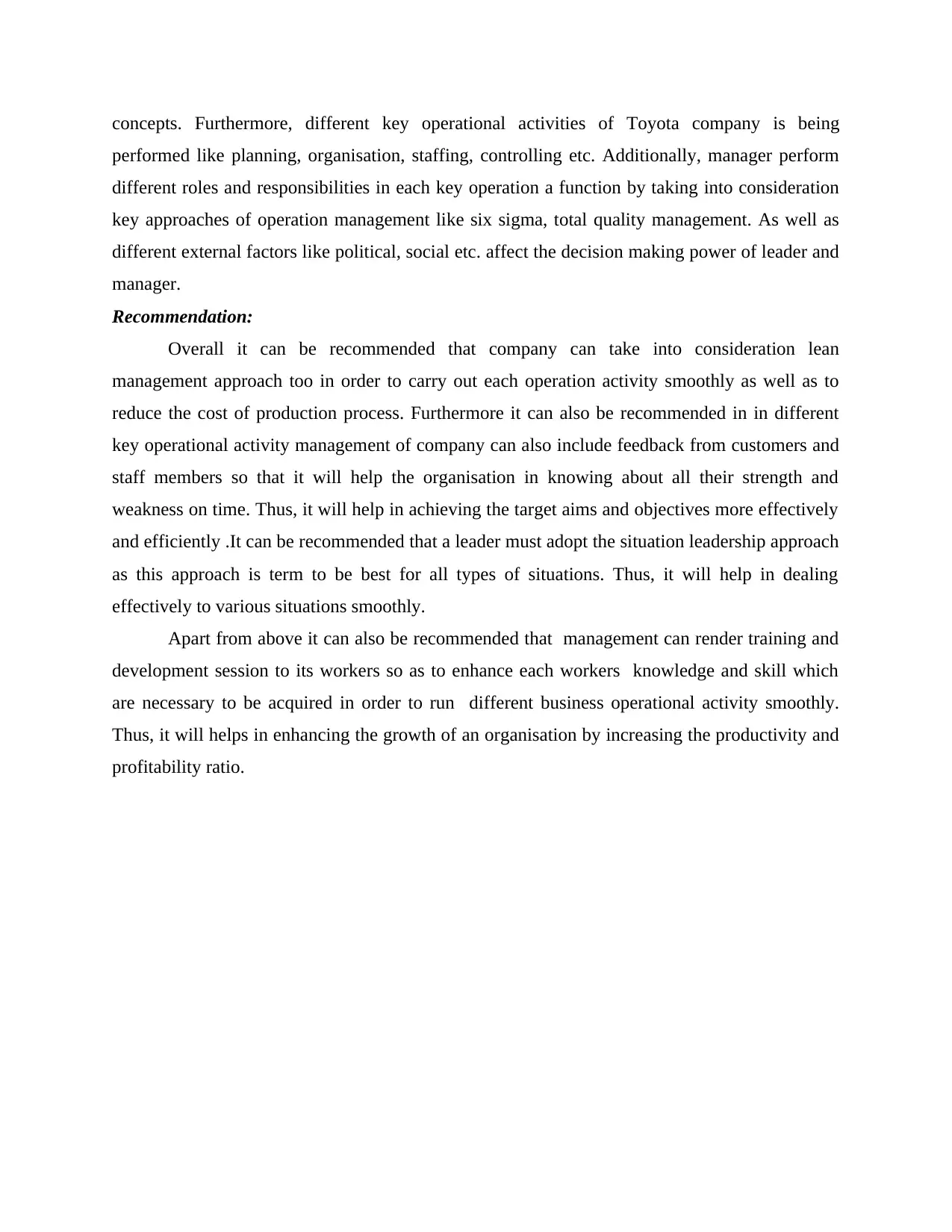
concepts. Furthermore, different key operational activities of Toyota company is being
performed like planning, organisation, staffing, controlling etc. Additionally, manager perform
different roles and responsibilities in each key operation a function by taking into consideration
key approaches of operation management like six sigma, total quality management. As well as
different external factors like political, social etc. affect the decision making power of leader and
manager.
Recommendation:
Overall it can be recommended that company can take into consideration lean
management approach too in order to carry out each operation activity smoothly as well as to
reduce the cost of production process. Furthermore it can also be recommended in in different
key operational activity management of company can also include feedback from customers and
staff members so that it will help the organisation in knowing about all their strength and
weakness on time. Thus, it will help in achieving the target aims and objectives more effectively
and efficiently .It can be recommended that a leader must adopt the situation leadership approach
as this approach is term to be best for all types of situations. Thus, it will help in dealing
effectively to various situations smoothly.
Apart from above it can also be recommended that management can render training and
development session to its workers so as to enhance each workers knowledge and skill which
are necessary to be acquired in order to run different business operational activity smoothly.
Thus, it will helps in enhancing the growth of an organisation by increasing the productivity and
profitability ratio.
performed like planning, organisation, staffing, controlling etc. Additionally, manager perform
different roles and responsibilities in each key operation a function by taking into consideration
key approaches of operation management like six sigma, total quality management. As well as
different external factors like political, social etc. affect the decision making power of leader and
manager.
Recommendation:
Overall it can be recommended that company can take into consideration lean
management approach too in order to carry out each operation activity smoothly as well as to
reduce the cost of production process. Furthermore it can also be recommended in in different
key operational activity management of company can also include feedback from customers and
staff members so that it will help the organisation in knowing about all their strength and
weakness on time. Thus, it will help in achieving the target aims and objectives more effectively
and efficiently .It can be recommended that a leader must adopt the situation leadership approach
as this approach is term to be best for all types of situations. Thus, it will help in dealing
effectively to various situations smoothly.
Apart from above it can also be recommended that management can render training and
development session to its workers so as to enhance each workers knowledge and skill which
are necessary to be acquired in order to run different business operational activity smoothly.
Thus, it will helps in enhancing the growth of an organisation by increasing the productivity and
profitability ratio.
Secure Best Marks with AI Grader
Need help grading? Try our AI Grader for instant feedback on your assignments.
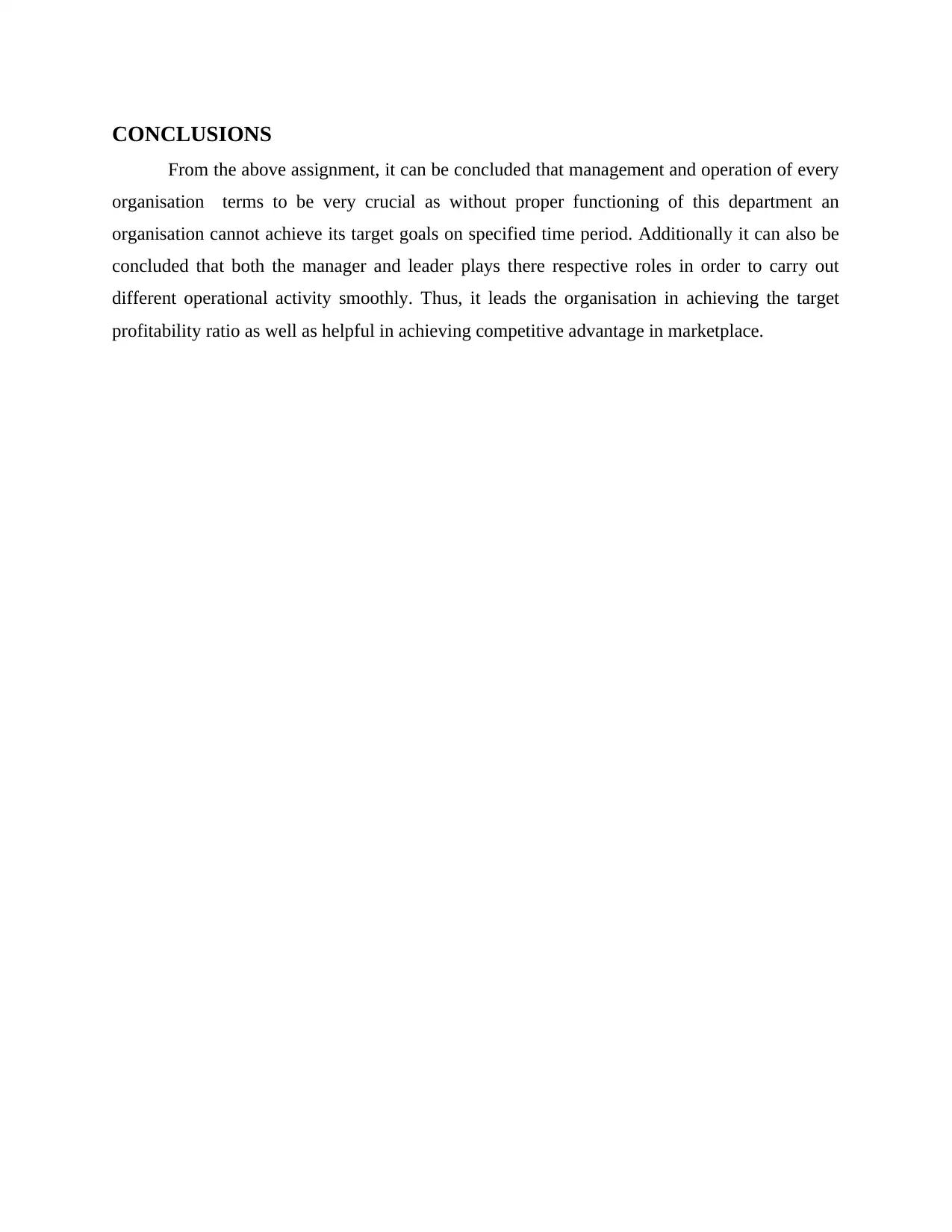
CONCLUSIONS
From the above assignment, it can be concluded that management and operation of every
organisation terms to be very crucial as without proper functioning of this department an
organisation cannot achieve its target goals on specified time period. Additionally it can also be
concluded that both the manager and leader plays there respective roles in order to carry out
different operational activity smoothly. Thus, it leads the organisation in achieving the target
profitability ratio as well as helpful in achieving competitive advantage in marketplace.
From the above assignment, it can be concluded that management and operation of every
organisation terms to be very crucial as without proper functioning of this department an
organisation cannot achieve its target goals on specified time period. Additionally it can also be
concluded that both the manager and leader plays there respective roles in order to carry out
different operational activity smoothly. Thus, it leads the organisation in achieving the target
profitability ratio as well as helpful in achieving competitive advantage in marketplace.
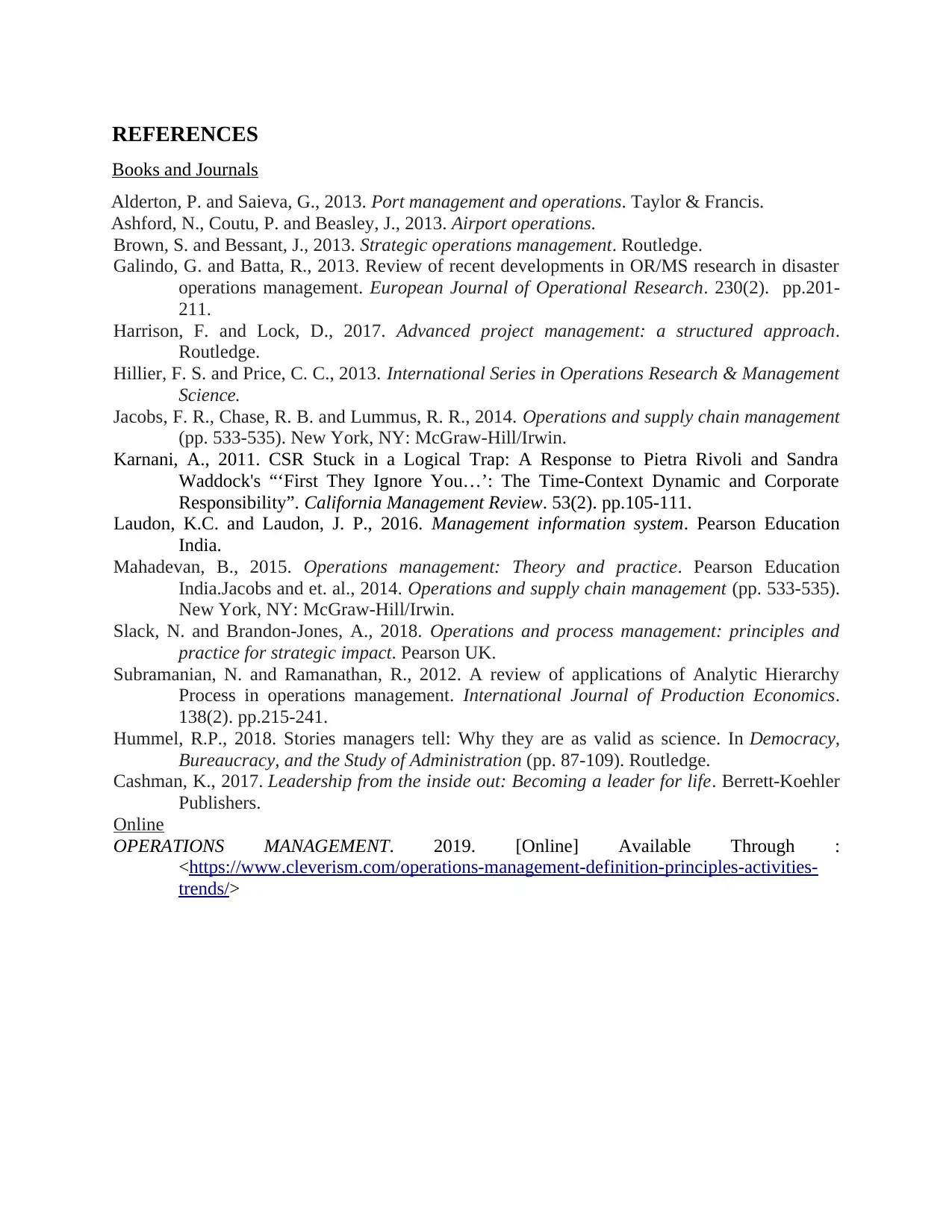
REFERENCES
Books and Journals
Alderton, P. and Saieva, G., 2013. Port management and operations. Taylor & Francis.
Ashford, N., Coutu, P. and Beasley, J., 2013. Airport operations.
Brown, S. and Bessant, J., 2013. Strategic operations management. Routledge.
Galindo, G. and Batta, R., 2013. Review of recent developments in OR/MS research in disaster
operations management. European Journal of Operational Research. 230(2). pp.201-
211.
Harrison, F. and Lock, D., 2017. Advanced project management: a structured approach.
Routledge.
Hillier, F. S. and Price, C. C., 2013. International Series in Operations Research & Management
Science.
Jacobs, F. R., Chase, R. B. and Lummus, R. R., 2014. Operations and supply chain management
(pp. 533-535). New York, NY: McGraw-Hill/Irwin.
Karnani, A., 2011. CSR Stuck in a Logical Trap: A Response to Pietra Rivoli and Sandra
Waddock's “‘First They Ignore You…’: The Time-Context Dynamic and Corporate
Responsibility”. California Management Review. 53(2). pp.105-111.
Laudon, K.C. and Laudon, J. P., 2016. Management information system. Pearson Education
India.
Mahadevan, B., 2015. Operations management: Theory and practice. Pearson Education
India.Jacobs and et. al., 2014. Operations and supply chain management (pp. 533-535).
New York, NY: McGraw-Hill/Irwin.
Slack, N. and Brandon-Jones, A., 2018. Operations and process management: principles and
practice for strategic impact. Pearson UK.
Subramanian, N. and Ramanathan, R., 2012. A review of applications of Analytic Hierarchy
Process in operations management. International Journal of Production Economics.
138(2). pp.215-241.
Hummel, R.P., 2018. Stories managers tell: Why they are as valid as science. In Democracy,
Bureaucracy, and the Study of Administration (pp. 87-109). Routledge.
Cashman, K., 2017. Leadership from the inside out: Becoming a leader for life. Berrett-Koehler
Publishers.
Online
OPERATIONS MANAGEMENT. 2019. [Online] Available Through :
<https://www.cleverism.com/operations-management-definition-principles-activities-
trends/>
Books and Journals
Alderton, P. and Saieva, G., 2013. Port management and operations. Taylor & Francis.
Ashford, N., Coutu, P. and Beasley, J., 2013. Airport operations.
Brown, S. and Bessant, J., 2013. Strategic operations management. Routledge.
Galindo, G. and Batta, R., 2013. Review of recent developments in OR/MS research in disaster
operations management. European Journal of Operational Research. 230(2). pp.201-
211.
Harrison, F. and Lock, D., 2017. Advanced project management: a structured approach.
Routledge.
Hillier, F. S. and Price, C. C., 2013. International Series in Operations Research & Management
Science.
Jacobs, F. R., Chase, R. B. and Lummus, R. R., 2014. Operations and supply chain management
(pp. 533-535). New York, NY: McGraw-Hill/Irwin.
Karnani, A., 2011. CSR Stuck in a Logical Trap: A Response to Pietra Rivoli and Sandra
Waddock's “‘First They Ignore You…’: The Time-Context Dynamic and Corporate
Responsibility”. California Management Review. 53(2). pp.105-111.
Laudon, K.C. and Laudon, J. P., 2016. Management information system. Pearson Education
India.
Mahadevan, B., 2015. Operations management: Theory and practice. Pearson Education
India.Jacobs and et. al., 2014. Operations and supply chain management (pp. 533-535).
New York, NY: McGraw-Hill/Irwin.
Slack, N. and Brandon-Jones, A., 2018. Operations and process management: principles and
practice for strategic impact. Pearson UK.
Subramanian, N. and Ramanathan, R., 2012. A review of applications of Analytic Hierarchy
Process in operations management. International Journal of Production Economics.
138(2). pp.215-241.
Hummel, R.P., 2018. Stories managers tell: Why they are as valid as science. In Democracy,
Bureaucracy, and the Study of Administration (pp. 87-109). Routledge.
Cashman, K., 2017. Leadership from the inside out: Becoming a leader for life. Berrett-Koehler
Publishers.
Online
OPERATIONS MANAGEMENT. 2019. [Online] Available Through :
<https://www.cleverism.com/operations-management-definition-principles-activities-
trends/>
1 out of 18
Related Documents
Your All-in-One AI-Powered Toolkit for Academic Success.
+13062052269
info@desklib.com
Available 24*7 on WhatsApp / Email
![[object Object]](/_next/static/media/star-bottom.7253800d.svg)
Unlock your academic potential
© 2024 | Zucol Services PVT LTD | All rights reserved.





